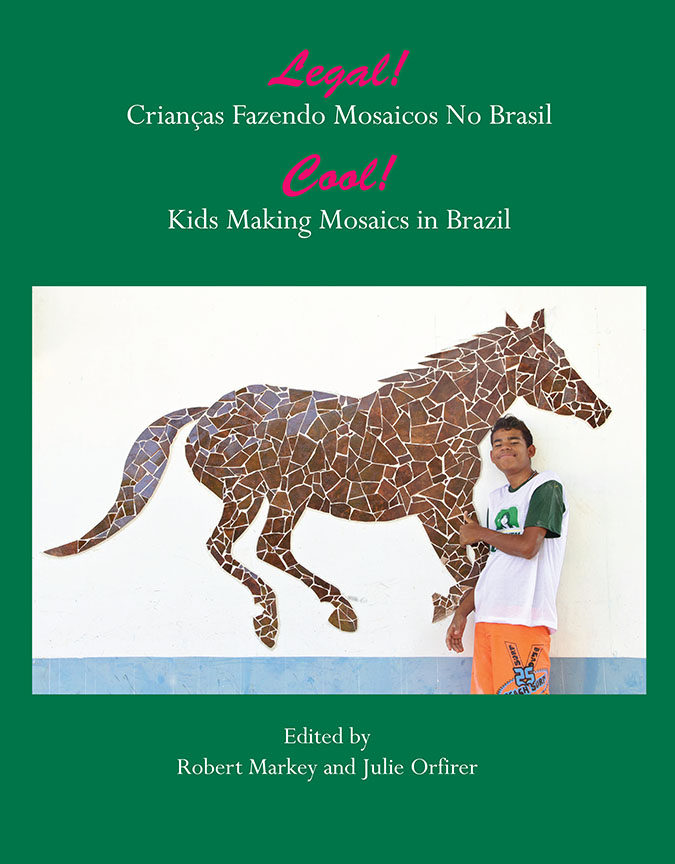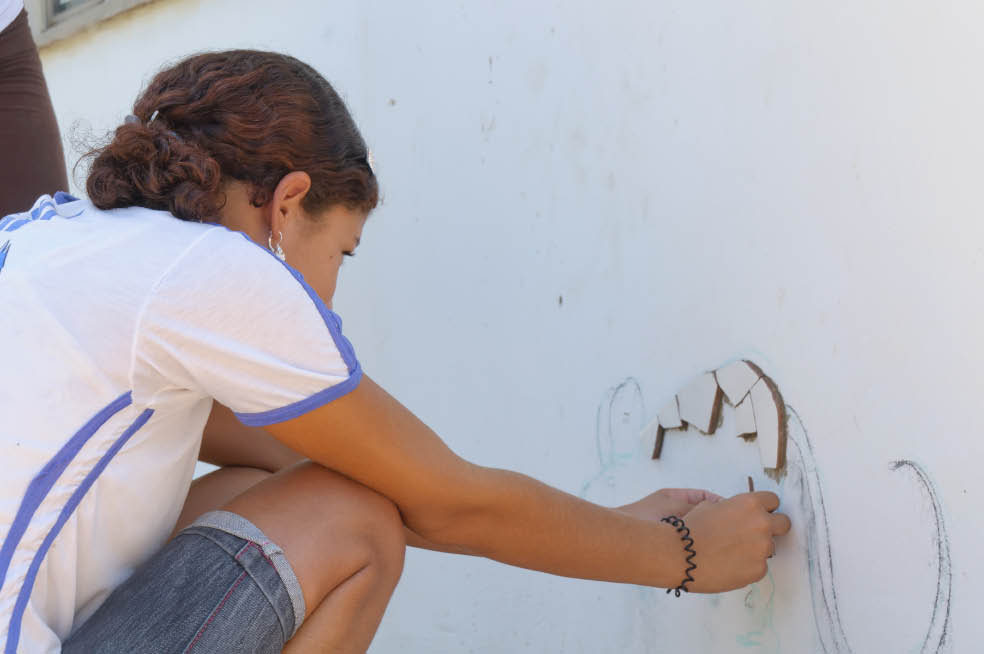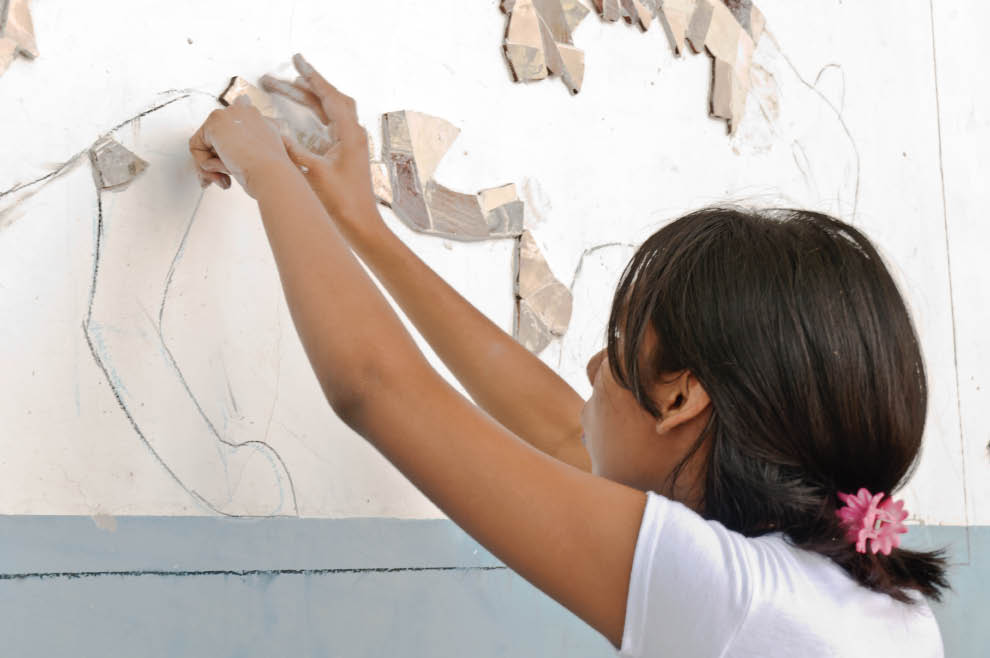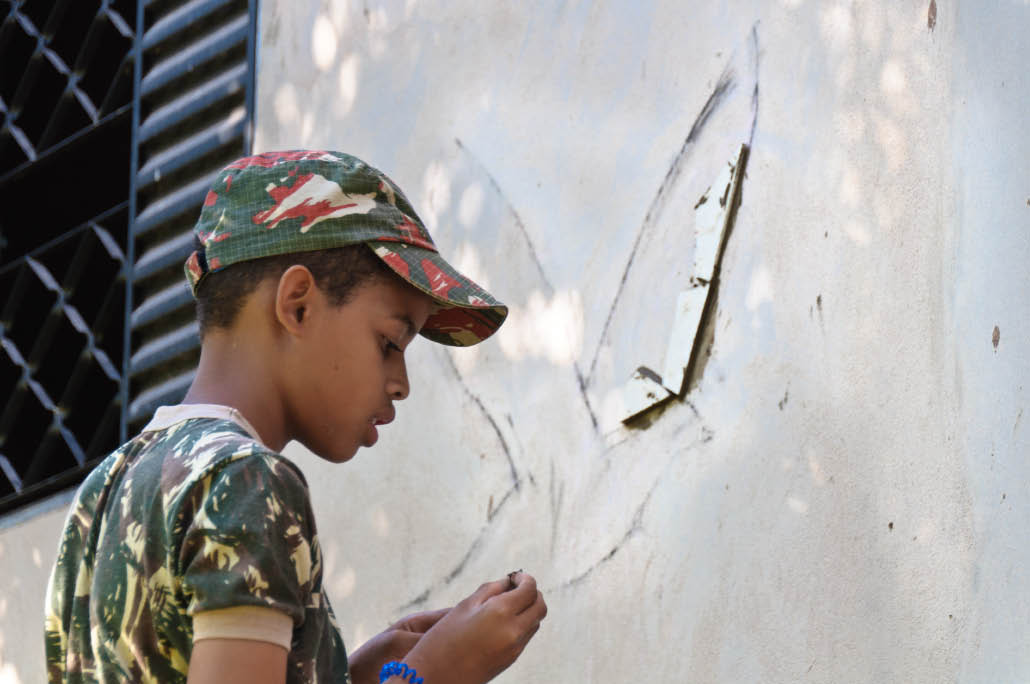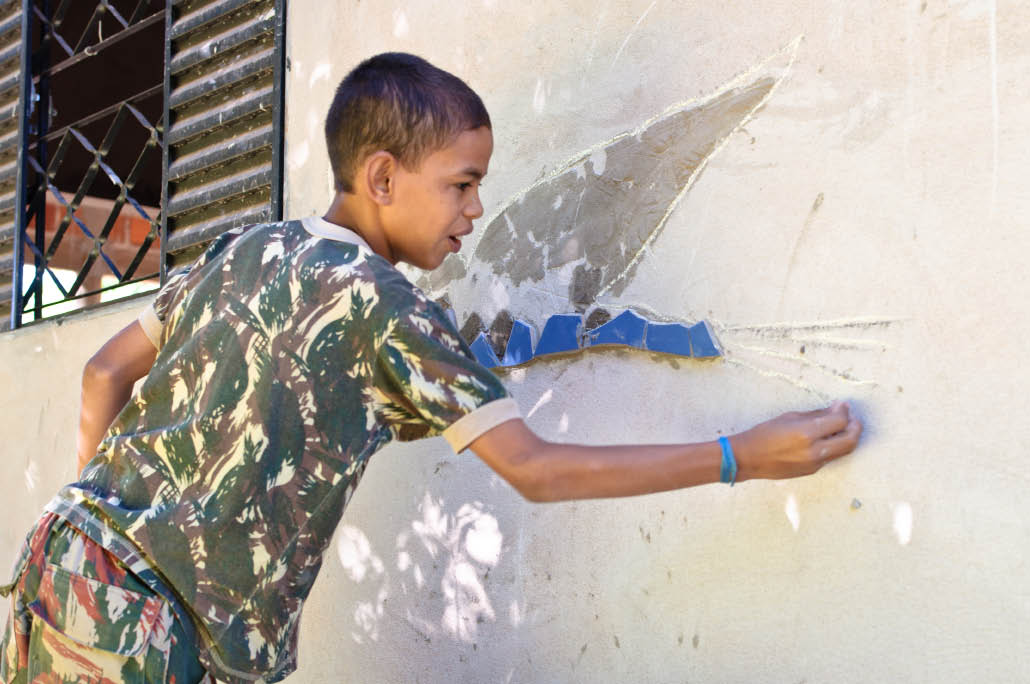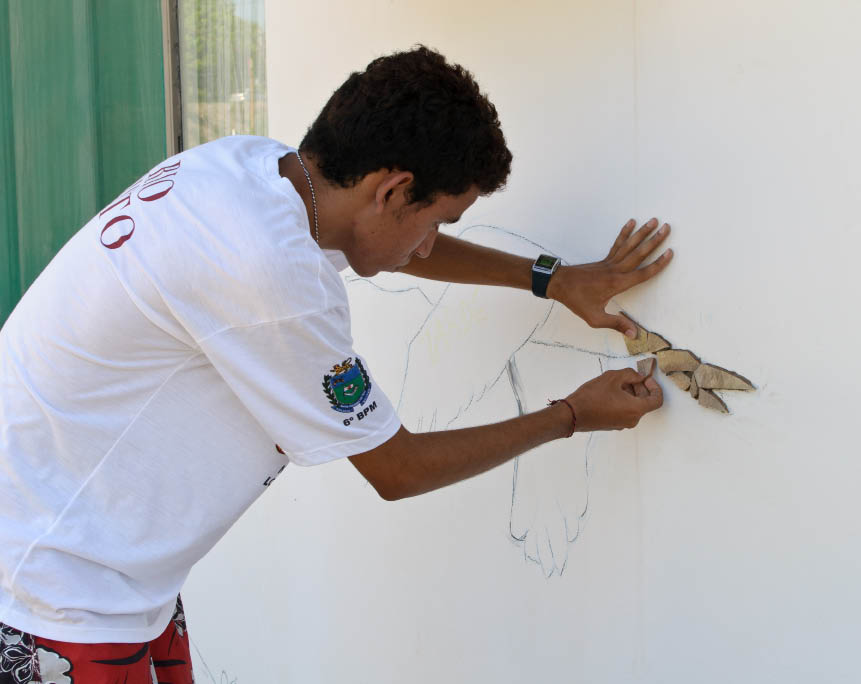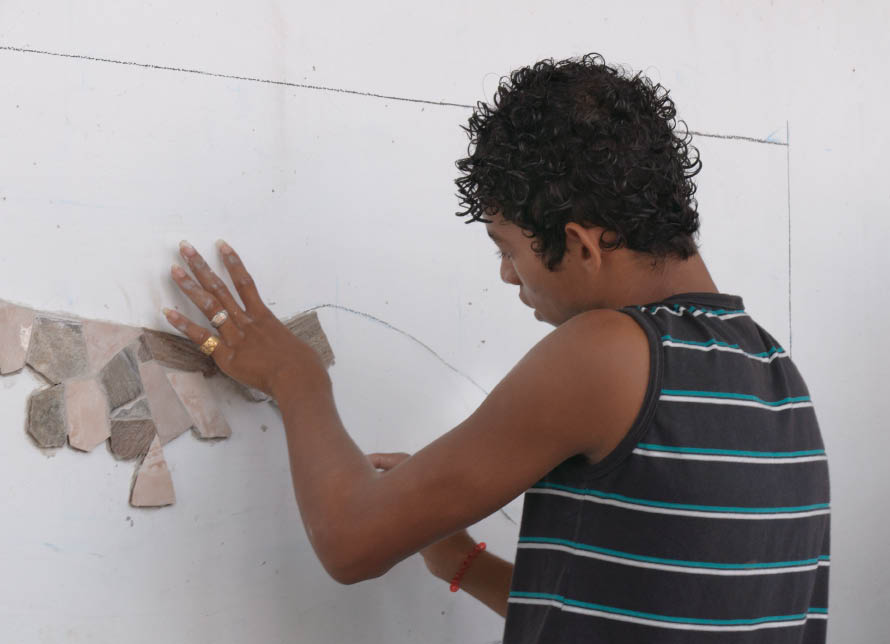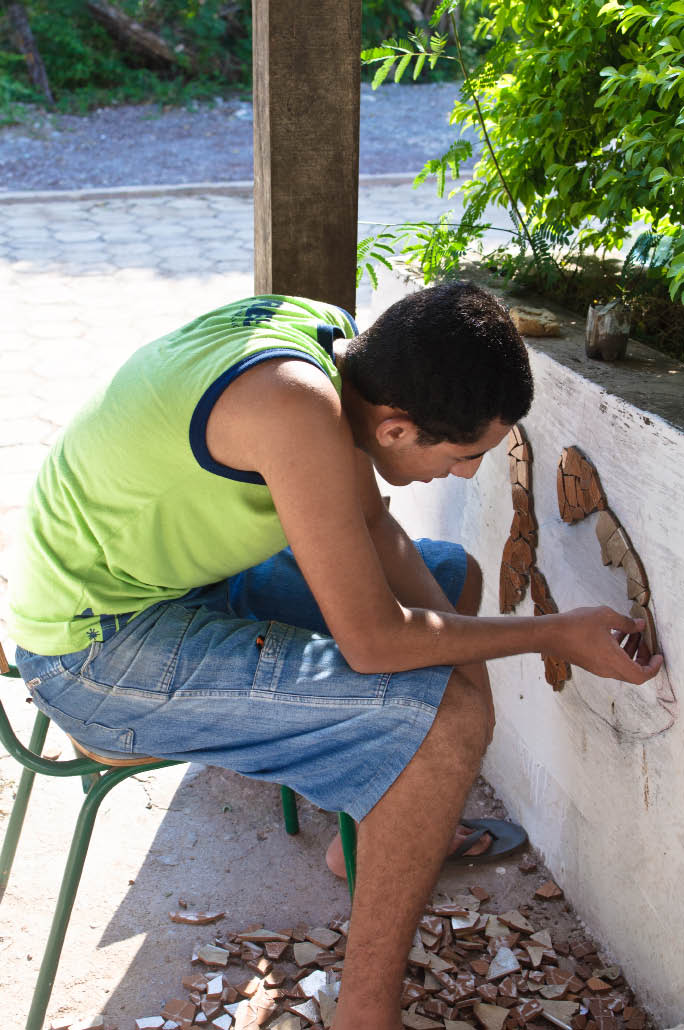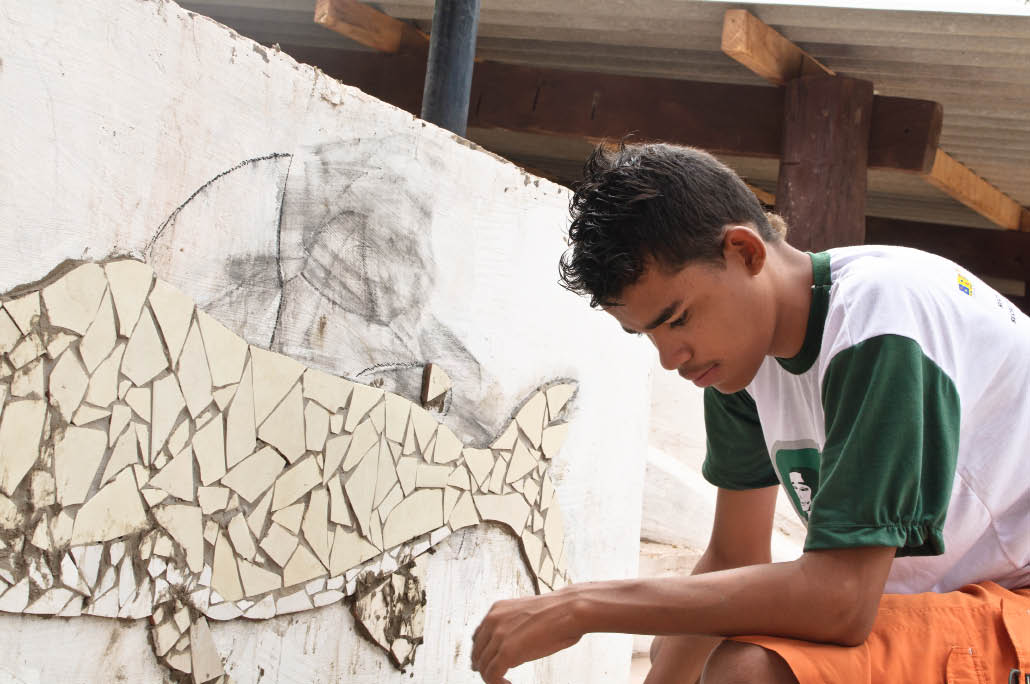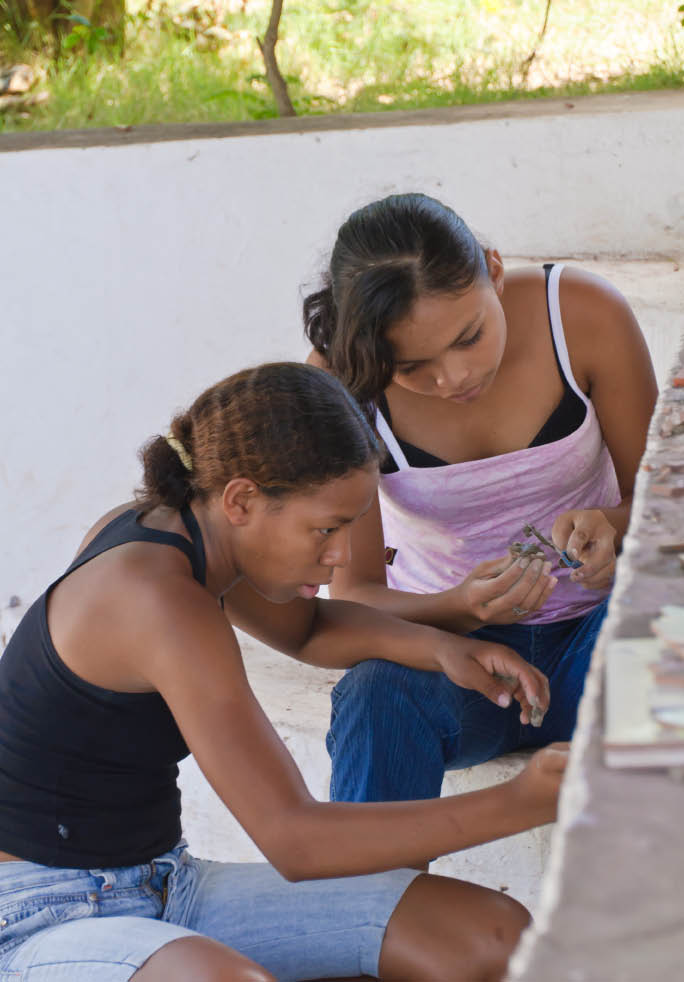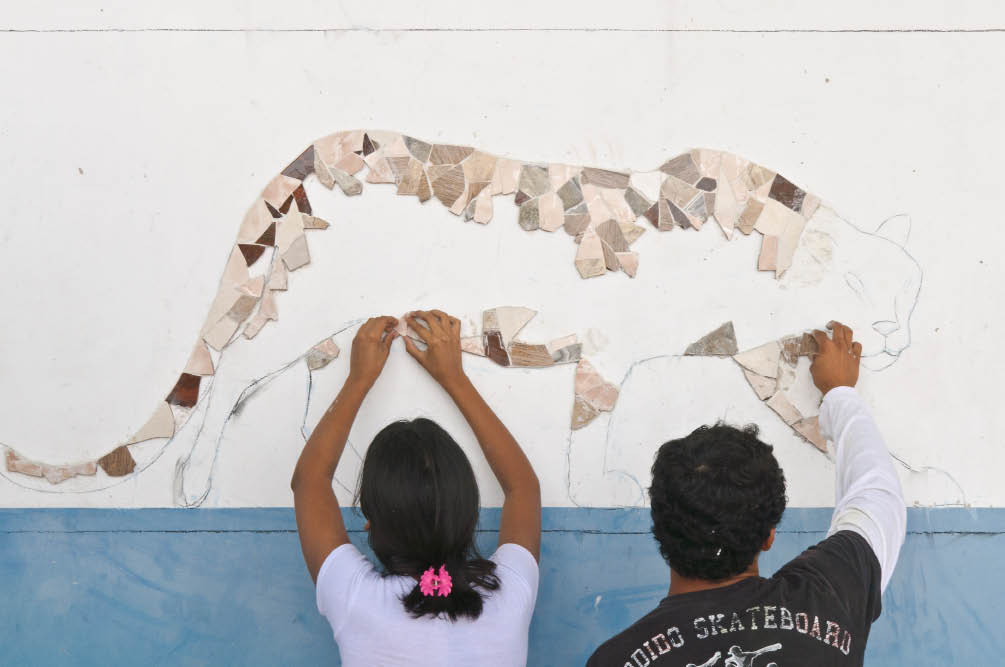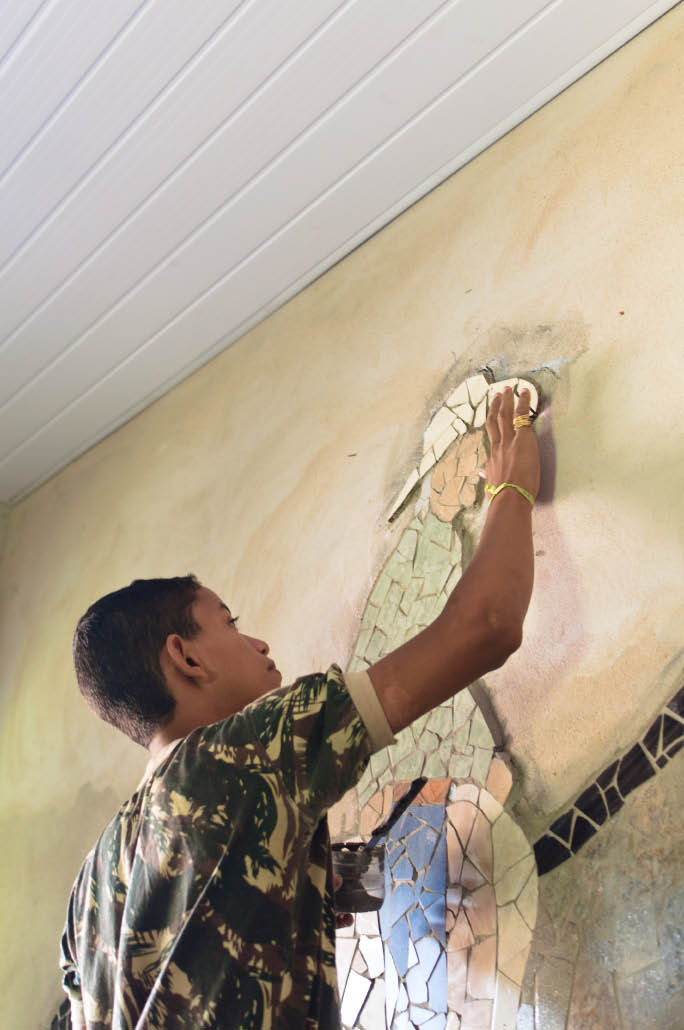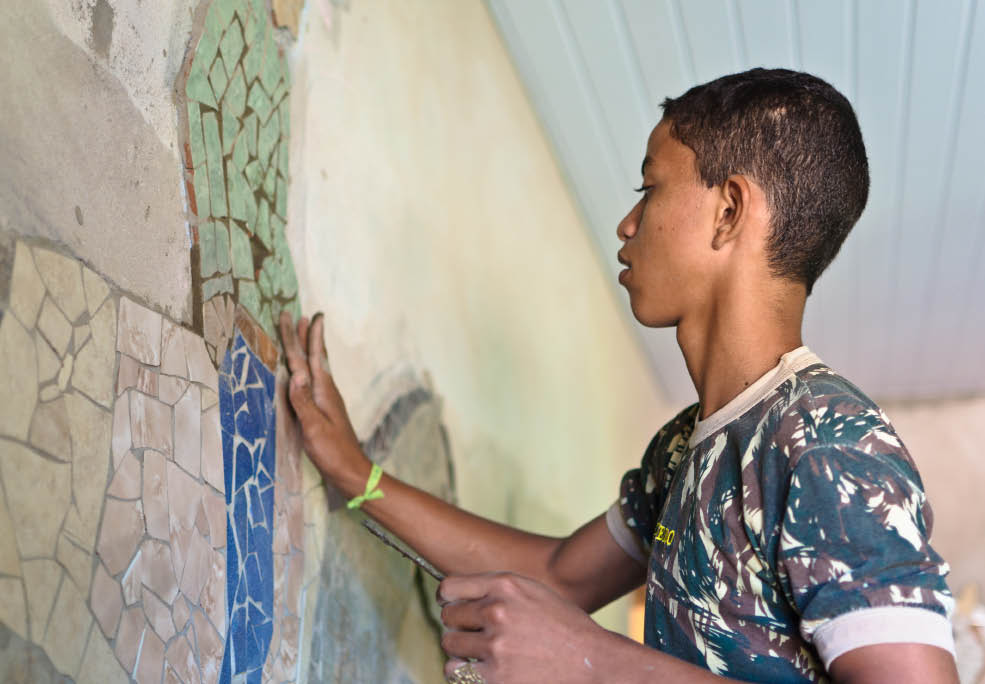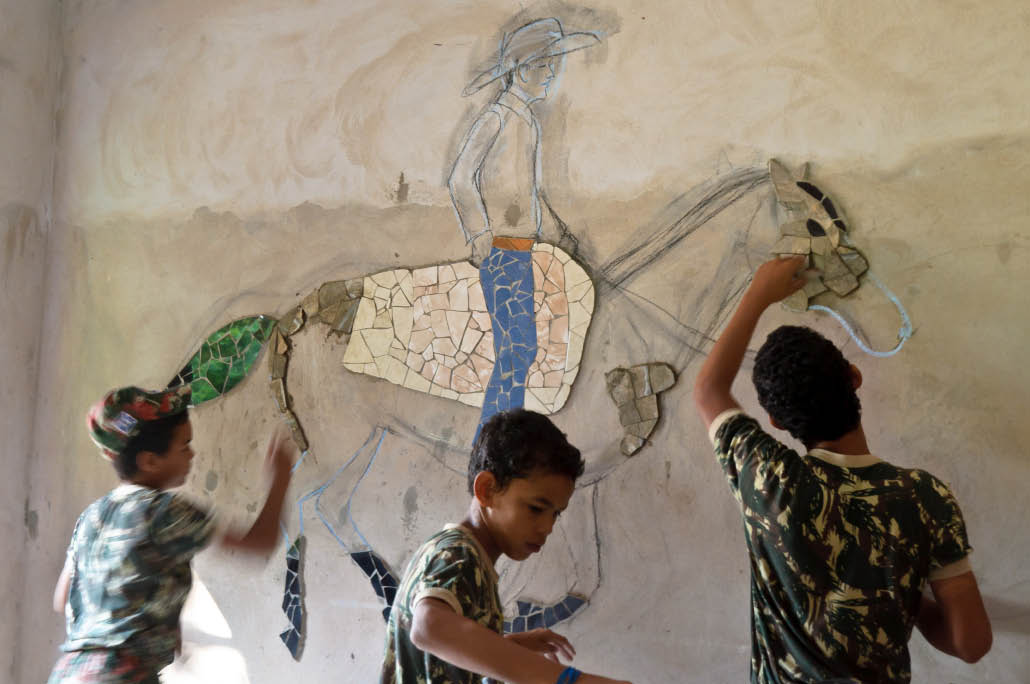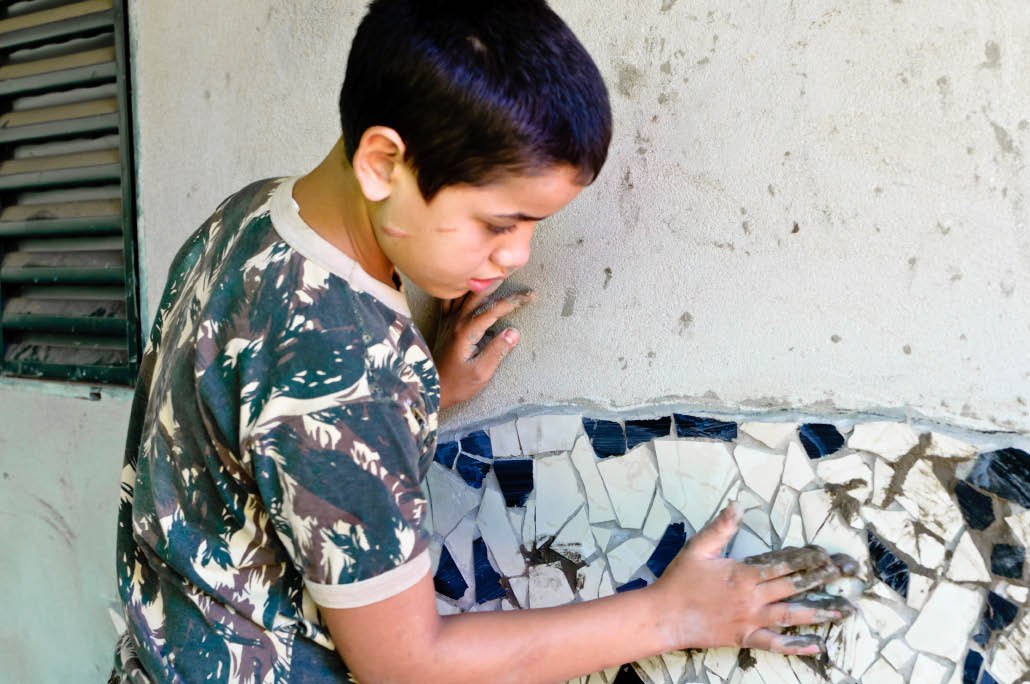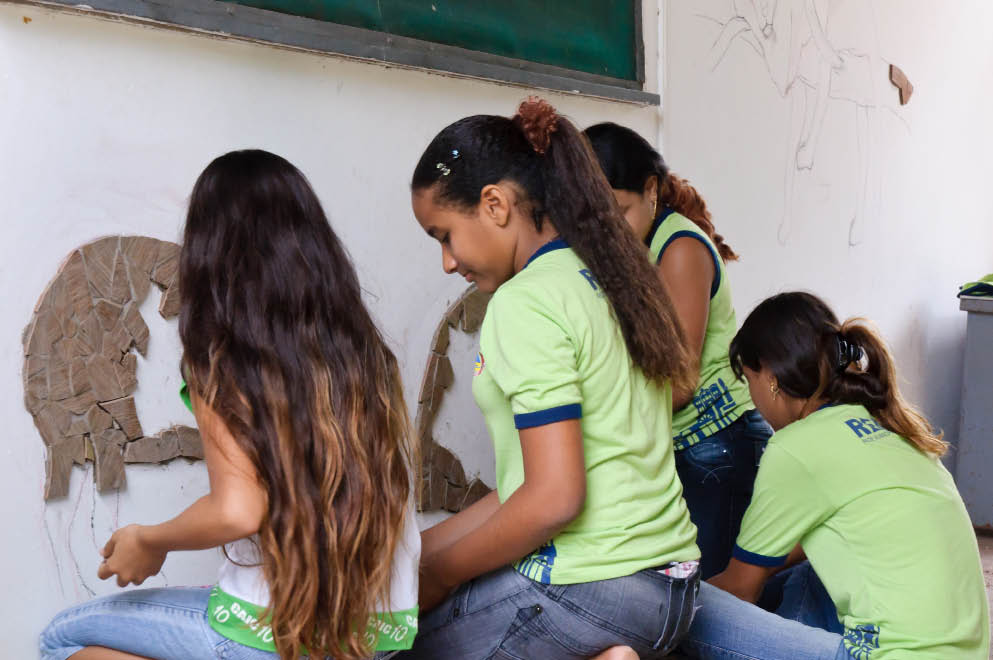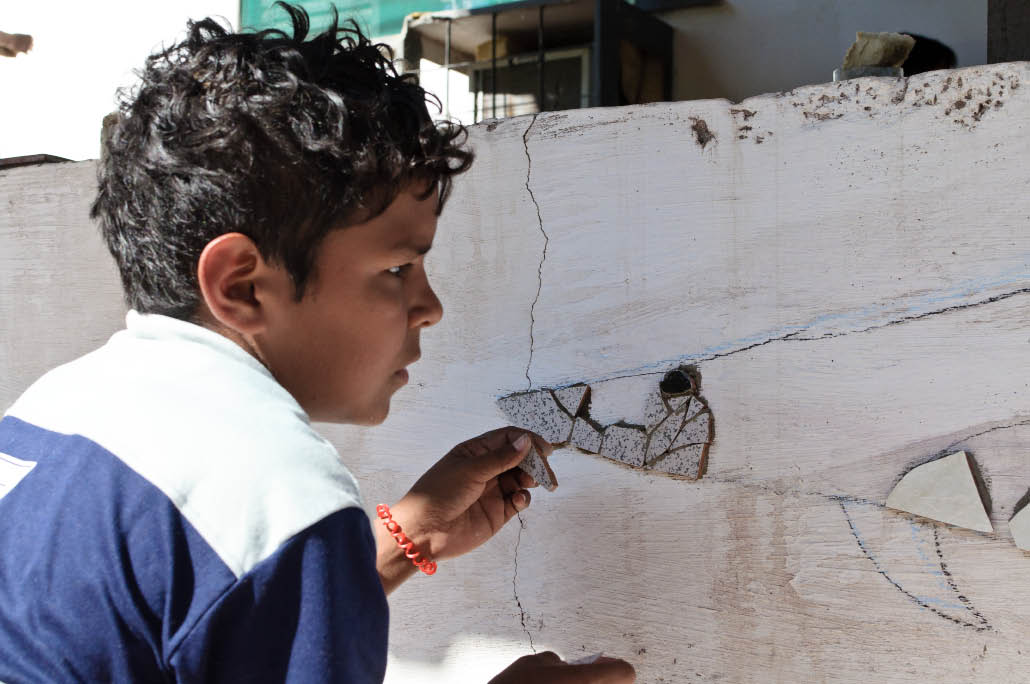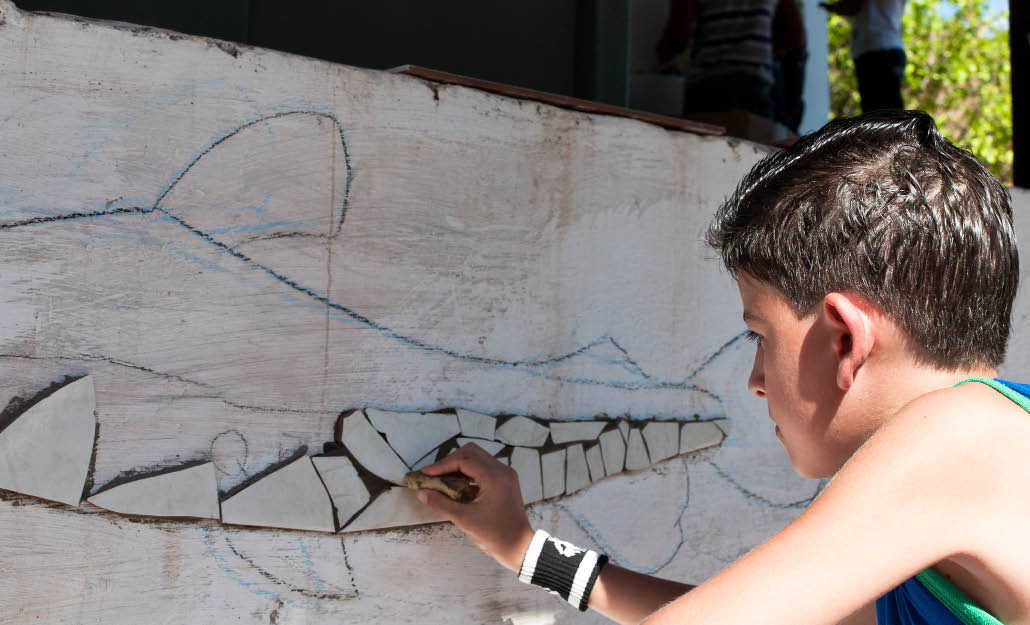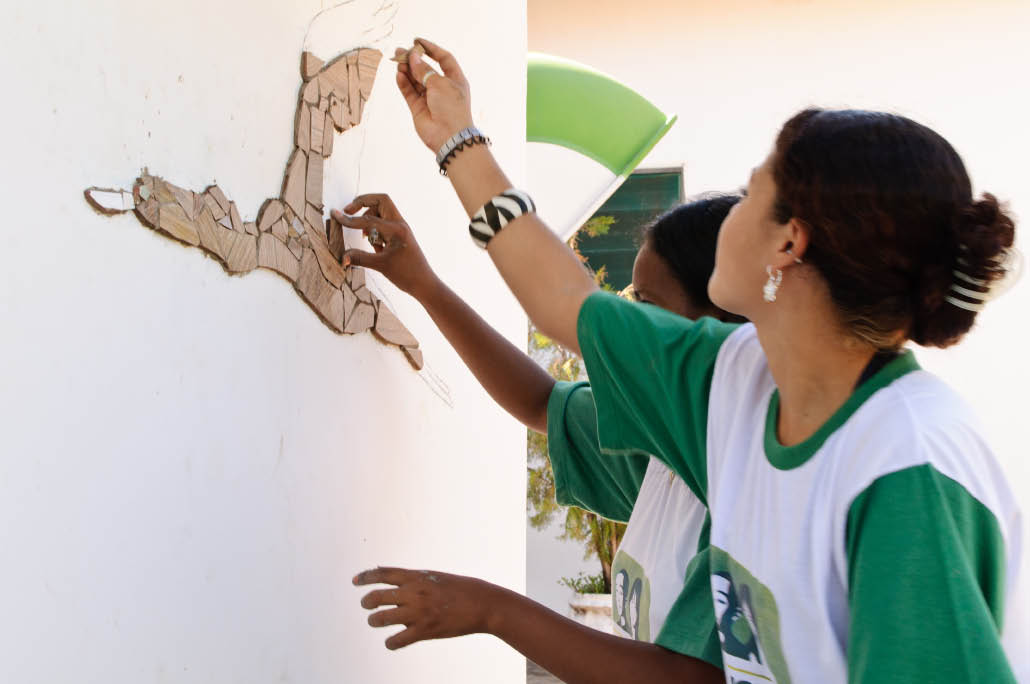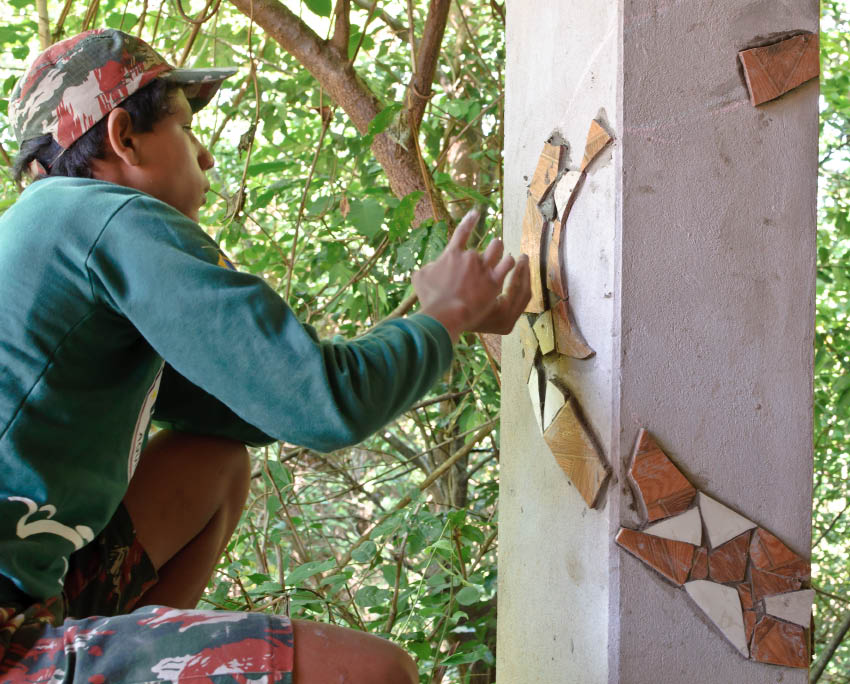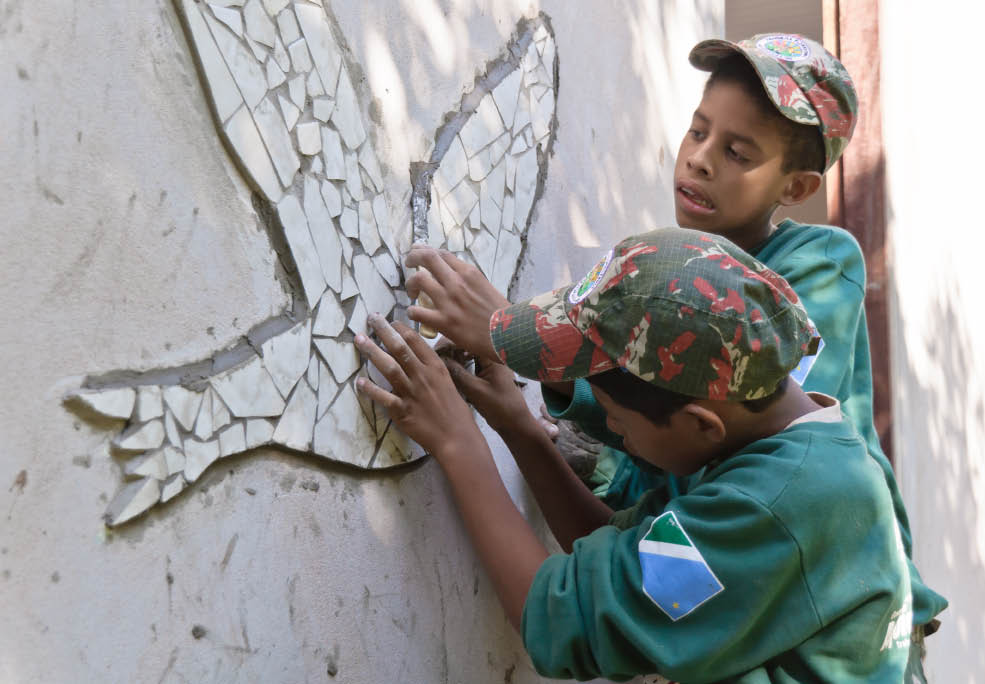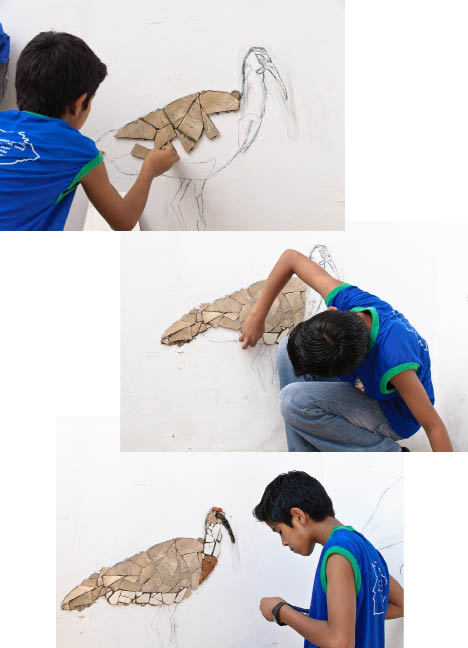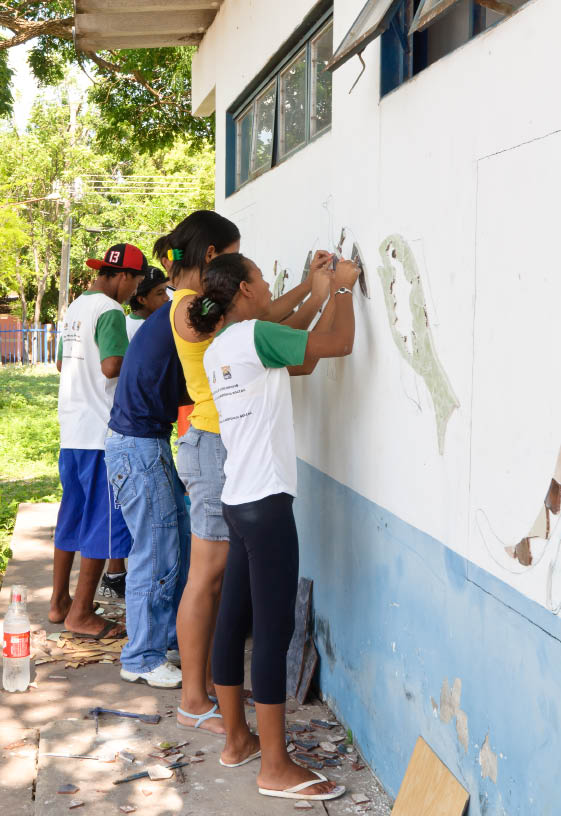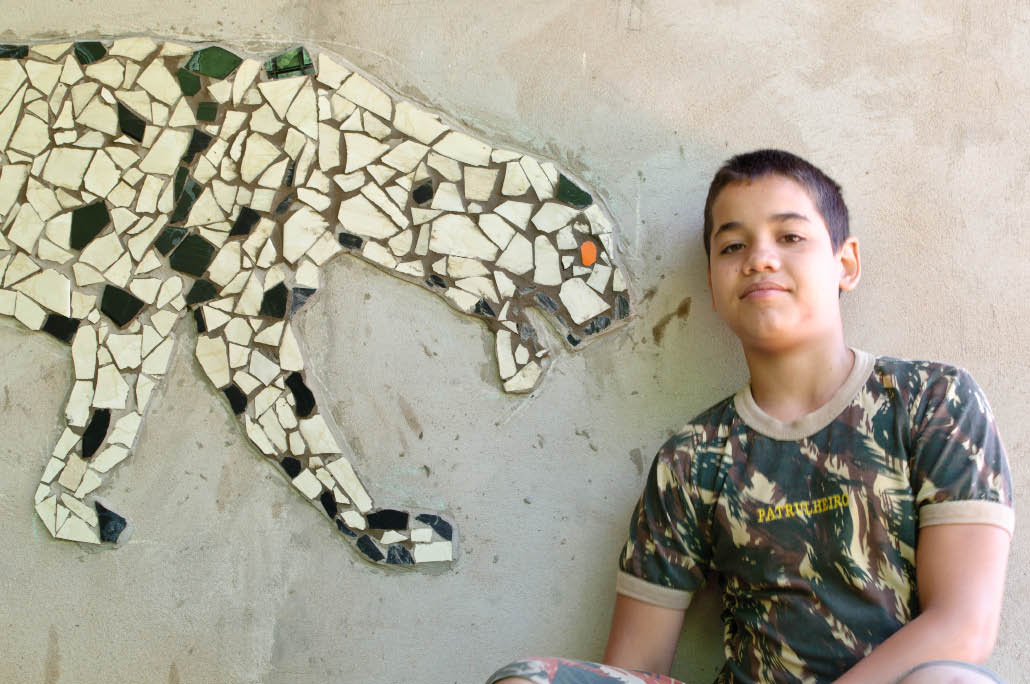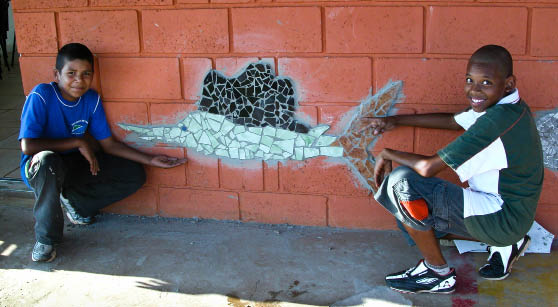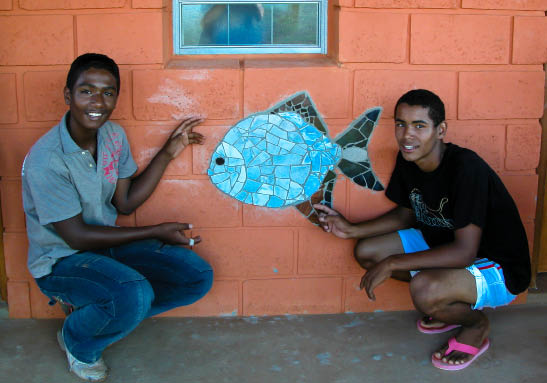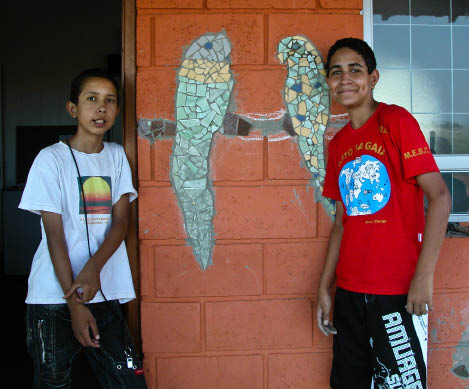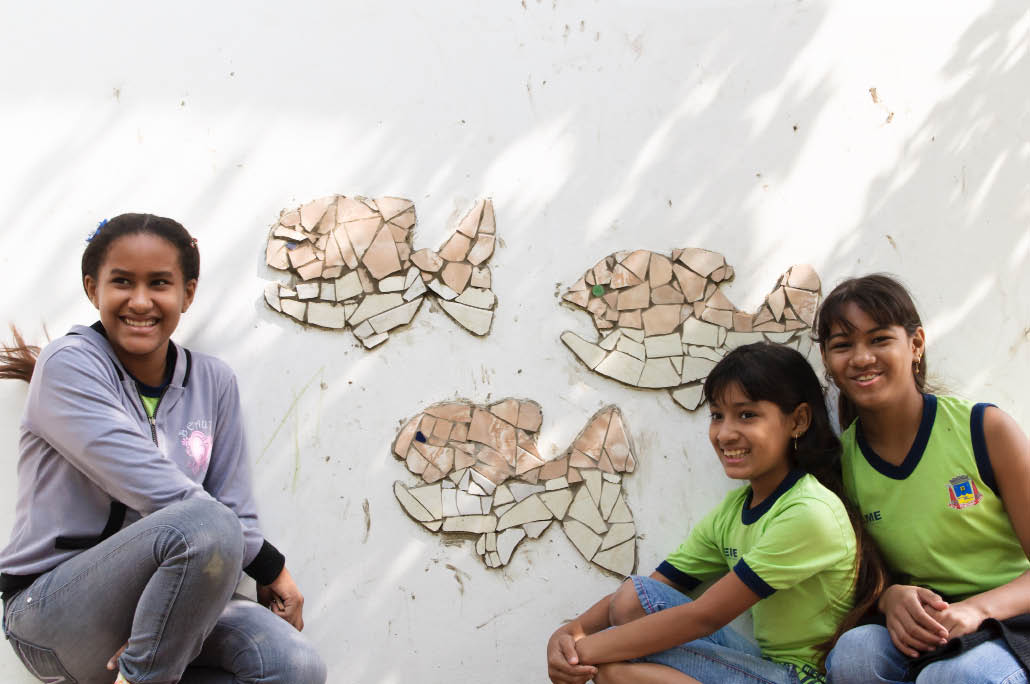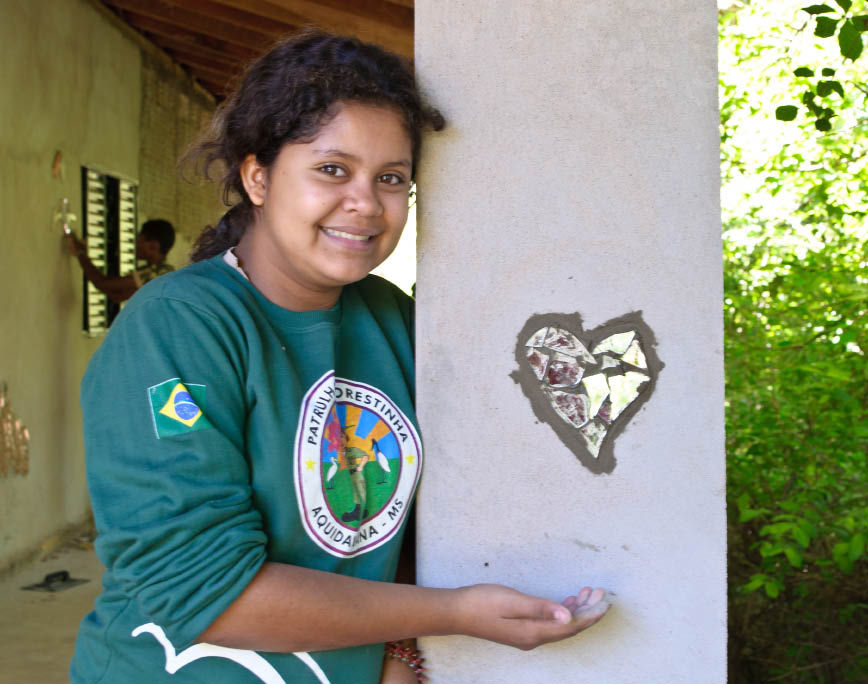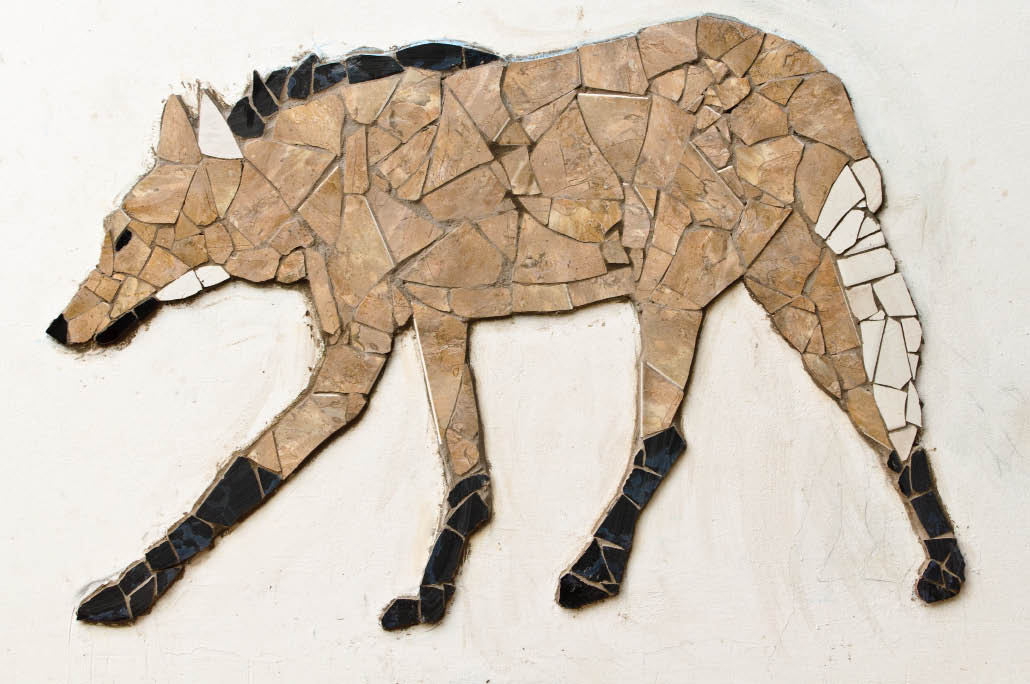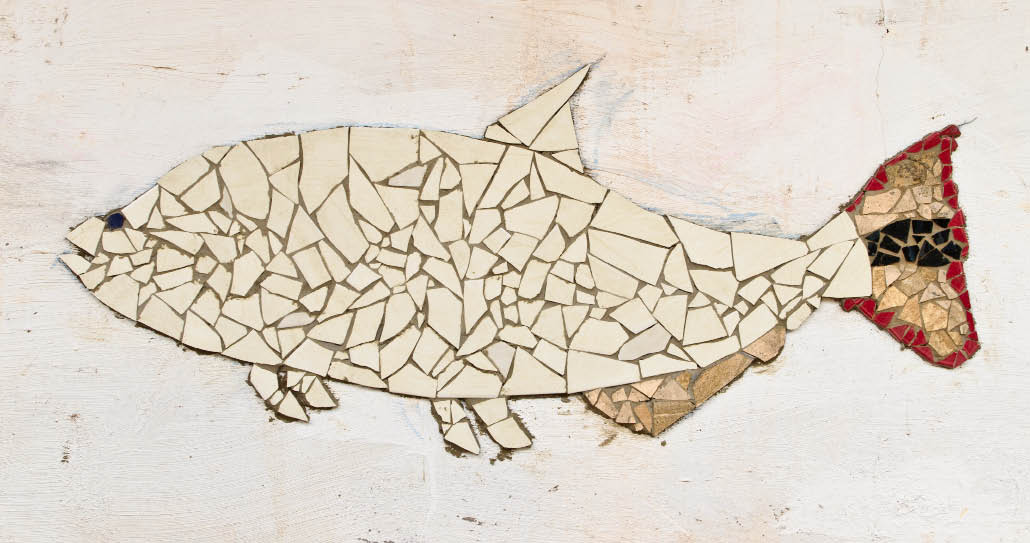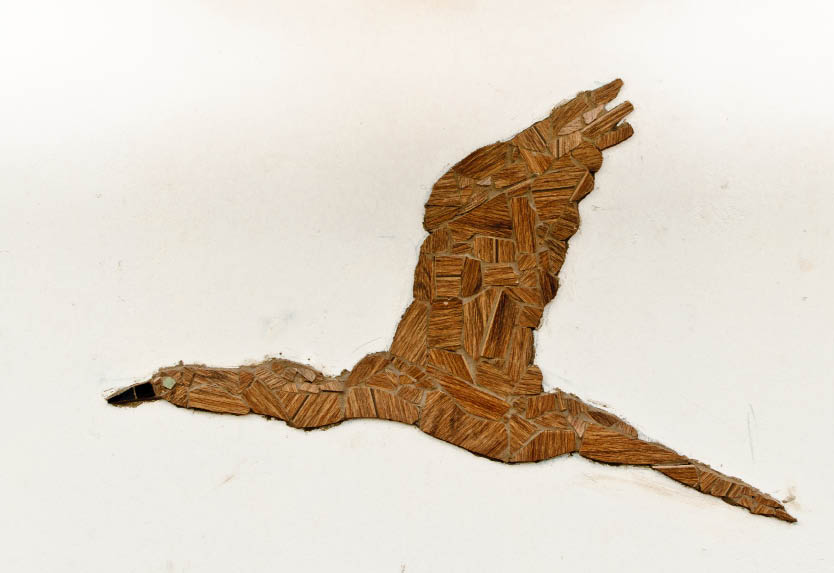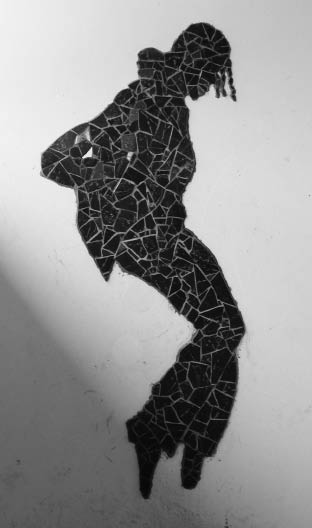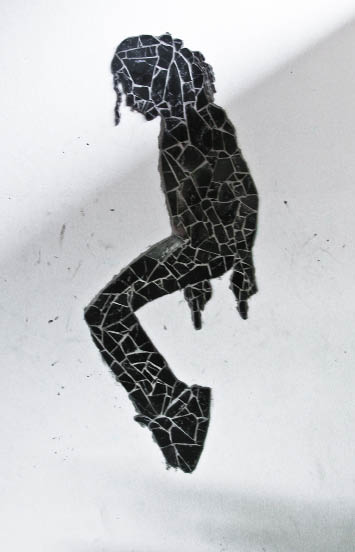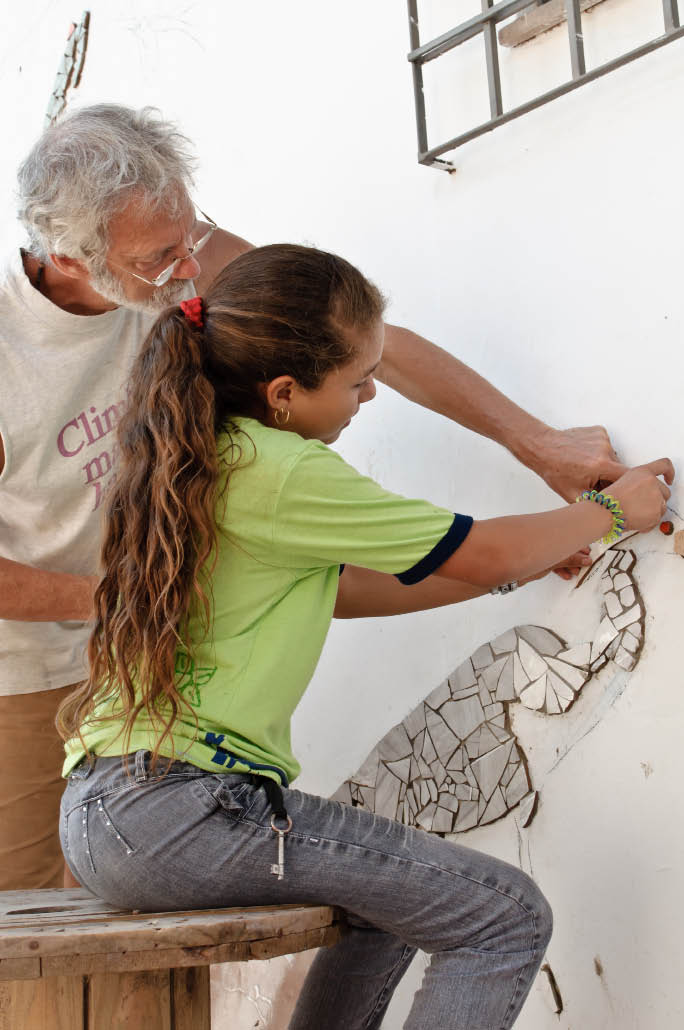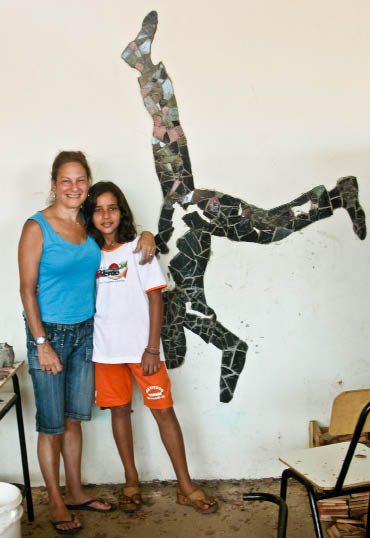Information on mosaic projects and artwork by Robert Markey at:
http://rmarkey.blue-fox.com
Copyright © 2011 Robert Markey and Julie Orfirer
Photographs Copyright © 2011 Julie Orfirer
ISBN 978-1467991926
Introdução
Um mosaico começa a partir de um conceito e um lugar: Uma parede, uma história a ser contada. Este projeto começou desta mesma forma. Em 2003 deixamos nossas vidas em Massachusetts para viver em algum outro lugar trabalhando como voluntários na área da saúde e das artes. Com grande alegria, o lugar em que desembarcamos foi o estado da Bahia, no nordeste do Brasil. Durante nosso tempo lá, duas sementes foram plantadas e foram se desenvolvendo ao longo de seis anos. A primeira delas foi ver os mosaicos de Bel Borba nas ruas de Salvador. A segunda foi o amor pelo povo brasileiro, particularmente nas cidadezinhas e vilarejos do interior do país.
Em 2008 Bob disse a seu amigo Peter Vacchina, quem tinham participado de projetos ambientais no Brasil, que nós adoraríamos voltar até lá e construir mosaicos. Peter respondeu dizendo que falaria com “O Capitão” para ver se havia interesse por parte dele. Capitão Queiroz, responsável pela Polícia Militar Ambiental em Campo Grande, Mato Grosso do Sul, gostou da idéia e por volta do outono 2009 ele já havia organizado projetos com mosaico em Campo Grande e Rio Verde para nós. Em 2010 começamos nossos trabalhos em Aquidauana e Corumbá.
O Pantanal é um ecossistema único localizado na região oeste do estado de Mato Grosso do Sul e nos foi solicitado que utilizássemos imagens dos animais nativos dessa região. Nós criamos mosaicos usando materiais reciclados: azulejos descartados por lojas de material de construção ou como sobras de algum projeto na casa de alguém; facas de cozinha velhas, pedras e outras ferramentas improvisadas de metal usadas como martelos para quebrar azulejos; recipientes feitos a partir do fundo de garrafas de refrigerante para manter argamassa, além de sobras de materiais esponjosos para a limpeza.
O tempo que passamos no Brasil foi extraordinário. Passamos grande parte dos dias trabalhando com diferentes grupos de crianças, ensinando-as o as técnicas do mosaico. Dando a elas a oportunidade de aprender algo novo—a dedicar-se durante o processo de aprendizado e ter algo para se orgulhar no final. Dando-lhes a oportunidade para que deixem suas marcas neste mundo; marcas que serão vistas e admiradas por suas comunidades. Ampliando-lhes a consciência ambiental através da familiaridade com os bichos que trouxeram à vida. Propiciando a eles uma habilidade para o trabalho, para ensinar ou apenas para possuir.
Muitas das crianças vieram de situações complicadas, cada uma das organizações com as quais trabalhamos estava lá para tentar propiciar um futuro mais promissor para crianças carentes. Fomos agraciados por ter pessoas tão dedicadas contribuindo e apreciando o que estávamos fazendo.
Foi um trabalho árduo, mas com momentos incríveis. Compartilhamos a língua, música, brincadeiras e cultura. Vimos o orgulho estampado em suas faces quando concluíam um mosaico. Muitas vezes os vizinhos iam assistir e maravilhar-se com aquilo que as crianças faziam. E à noite e aos finais de semana descobríamos a beleza dos pássaros, animais, árvores e flores do Pantanal.
Nós tentávamos vislumbrar o que havia nos mosaicos que intrigava tanto aquelas crianças a ponto de mantê-las trabalhando tão incessantemente em seus mosaicos. Parte disso talvez se deva às atividades físicas envolvidas no processo—quebrar os azulejos com o martelo, aplicar argamassa a cada peça e assentá-las na parede. Talvez fosse apenas impossível de interromper a visão do desenho tomando vida, começando pelas partes mais externas, continuando assentando peças, terminando a perna, o bico ou a calda, acrescentando mais um pedaço, e a obra esta feito. Ainda é possível que seja por ser arte pública—eles a veem todos os dias, seus amigos e vizinhos podem vê-la, e ele será visto por muitos anos vindouros.
As páginas deste livro contam uma história—sobre crianças, criação, o meio-ambiente, amor. E a fortuna que é oportunidade.
Robert Markey
Julie Orfirer
Ashfield, Massachusetts 2011
Introduction
A mosaic starts with a place and a concept: A wall, a story to be told. This project began in the same way. In 2003 we decided to put our lives in Massachusetts on hold and live somewhere else to do some volunteer work in art and health care. With great fortune, the place we landed was the northeastern Brazilian state of Bahia. During our time there, two seeds were planted that slowly ripened over the ensuing six years. The first was seeing the mosaics of Bel Borba on the streets of Salvador. The second was falling in love with the people of Brazil, particularly in the smaller cites and towns in the interior of the country.
In 2008 Bob mentioned to his good friend Peter Vacchina, who did environmental projects in Brazil, that we would love to go back and do more mosaics there. He said he would talk to “The Captain” and see if he was interested. Captain Queiroz, head of the Environmental Police in Campo Grande, Mato Grosso do Sul, liked the idea and by the Autumn of 2009 he had organized mosaic projects for us in Campo Grande and Rio Verde. In 2010 he set up projects in Aquidauana and in Corumba.
The Pantanal is a unique ecosystem in the western part of Mato Grosso do Sul and we were asked to use images of the animals of the Pantanal. We created mosaics with recycled materials: broken floor tiles from the backs of construction supply stores or leftover from someone’s house project; old kitchen knives, stones and odd metal implements to use as hammers to break tiles; cups cut off from the bottom of soda bottles to hold mortar; and leftover pieces of spongy insulation material for cleaning.
The time in Brazil was extraordinary for us. We spent many hours of the day working with different groups of kids, teaching them the mosaic process. Giving them the opportunity to learn something new—to struggle through the learning curve and have something to be very proud of at the end. Letting them leave a mark on the world that will be seen and appreciated by their community. Increasing their awareness of their environment through getting to know the animals that they bring to life. Leaving them with a useful skill that they may choose to do as work, to teach, or just to have.
Most of the kids came from difficult situations, each of the organizations we worked with were there to help create a better future for disadvantaged children. We were fortunate to have such dedicated adults supporting and appreciating the work we were doing.
It was hard work and we had a great time doing it. We shared language, music, games, and cultures. We saw the incredible pride in the kids’ faces when they finished a mosaic. Often the neighbors would come by to watch and be amazed at what the kids were doing. And in the evenings and on the weekends we discovered the beauty of the birds, animals, trees, and flowers of the Pantanal.
We have often wondered what it is about mosaics that intrigues the kids so much that they will work incessantly on their mosaics. Part of it may be the physicality of the process—breaking the tiles with a hammer, buttering each piece with mortar and putting it up on the wall. It may be the continuity of watching a drawing come to life—starting with the outside, putting more pieces up, finishing the leg, the beak or the tail, adding one more piece and then the work is done. And it may be that it is public art—they can see it every day, their friends and neighbors can see it, and it will be seen for many years to come.
The pages of this book tell a story—about kids, creation, the environment, love. And the fortune that is opportunity.
Robert Markey
Julie Orfirer
Ashfield, Massachusetts 2011
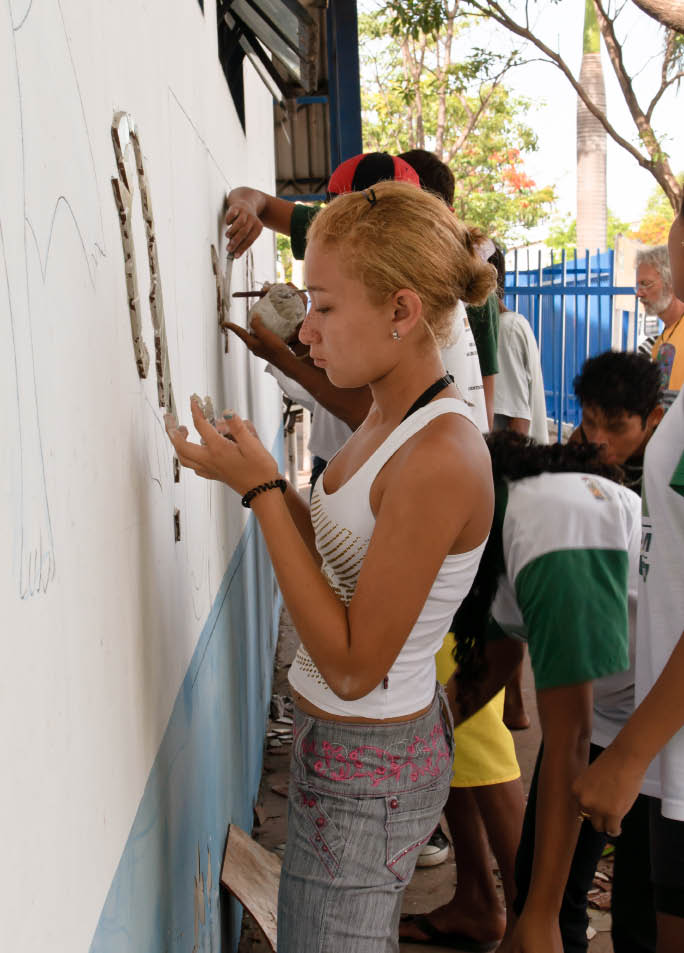
Primeiros Passos
A IMPORTÂNCIA DA ARTE NA VIDA DA CRIANÇA
Dentro da aprendizagem da arte com crianças há, a necessidade dos educadores se colocarem em seu lugar, ou seja, de olhar o mundo através do seu olhar. Adverte que para um adulto o que ás vezes lhe parece insignificante, no que diz respeito á expressão da criança, na verdade se traduz numa expressão do confronto consigo mesmo, de olhar para o seu próprio “eu”. Aprender artes, é muito mais do que um simples desenhar sem objectivo, mas expressar seus sentimentos, suas reflexões, seu raciocínio e suas habilidades para pensar. A riqueza da sensibilidade em avaliar um trabalho de arte na criança está em perceber e poder compreender a sua expressividade. O use constante de arte na vida da criança é de total importância para o desenvolvimento sadio do seu intelecto e emoções.
O Instituto Mirim tem uma preocupação muito grande com a reciclagem, visando com isso a diminuição de danos ambientais, objectivando a preservação do meio ambiente, o uso racional de materiais reciclado, especialmente com o público infanto-juvenil. A criança adolescia são multiplicadores de conhecimento, a cultura de pensamentos e sentimentos. Através da arte motive-se o público infanto-juvenil a uma mudança de atitude com o meio ambiente e a promoção de equilíbrio da vida. Dando uma nova visão de mundo e novas perspectivas de vida.
Patricia Pereira Moises, Diretora—Instituto Mirim, Rio Verde
Getting Started
THE IMPORTANCE OF ART IN THE LIFE OF THE CHILD
Within the art of learning with children there is the need for educators to put themselves in the child’s place and look at the world through his eyes. For an adult, that which sometimes seems insignificant, with regard to expression of the child, actually translates into an expression of the child’s understanding of himself, looking through his own self. Learning the arts is much more than just drawing with no purpose, but a way to express their feelings, their thoughts, their reasoning and their way of thinking. The richness of sensitivity in appreciating a child’s work of art is in the ability to perceive and understand their expressiveness. The constant use of art in children’s lives is important for the healthy development of their intellect and emotions.
The Mirim Institute is very concerned with recycling in order to lessen the harm of the environment so as to preserve it by using recycled materials especially with children. The adolescents are multipliers of knowledge, culture, thoughts, and feelings. Art is used to motivate the children to change their attitude on the environment and promote a balance in nature. And to give them a new worldview and new perspectives of life.
Patricia Pereira Moises, Director—Mirim Institute, Rio Verde
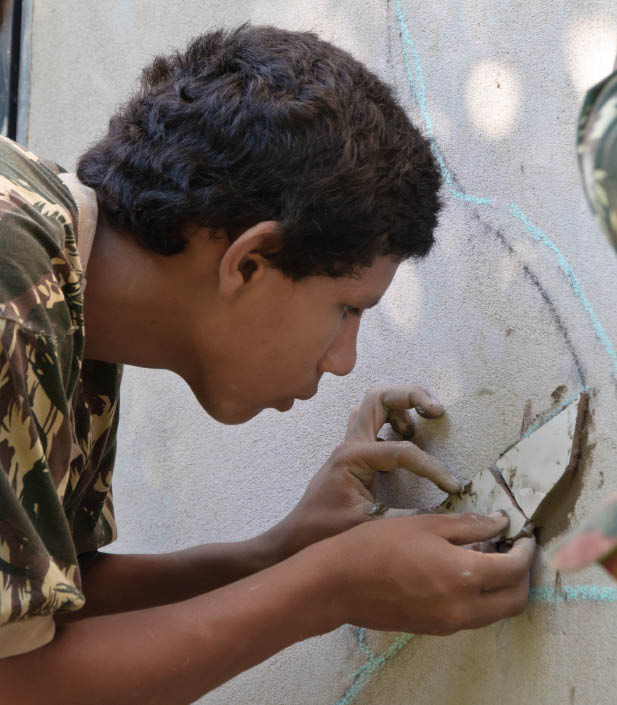
É importante para observar a beleza e a cultura. Se você vai a um lugar e é tudo branco, você precisa as pinturas e desenhos para fazer a diferença.
It’s important to observe beauty and culture. If you go to a place and it’s all blank, you have to have paintings and drawings to make a difference.
Então, para nós é importante mostrar a nossa cultura daqui para afora. É importante para a gente mostrar o que a gente tem aqui no Pantanal para outras pessoas através da arte e da cultura.
So, it is important for us to show our culture to people not from here. It is important for us to show what we have here in the Pantanal to other people through art and culture.
A parte mais difícil foi encaixar as peças uma na outra tudo certinho.
The hardest part was to fit the pieces together just right.
Fazer mosaico foi uma experiência nova na vida. Eu já sei, tenho mais ou menos, sei o que é o mosaico.
To make a mosaic was a new experience in life. Now I know, more or less, I know what a mosaic is.
A arte é assim, revolucionária. Todo mundo no mundo inteiro é assim.
Art is revolutionary. Everybody in the whole world is like that.
Sobre arte—é muito importante. As vezes arte para quem vive na rua não tem oportunidade de crescer na vida tem os projectos sociais que sempre envolvem a arte, envolvem dança, música, pintura. Então a importância de arte nesse ponto pode tirar algumas pessoas da rua. Até ganhar dinheiro também por que as vezes as pessoas pintam quadros e vendem para outros países que tem empresários que se interessam.
About art—it’s very important. There are some projects for those who live on the street and don’t have the opportunity to grow in life that involve art, involve dance, music, painting. So the importance of art then is that it can take some people from the street. To make money, too, because sometimes people paint pictures and sell them to other countries and to businesspeople who have an interest.
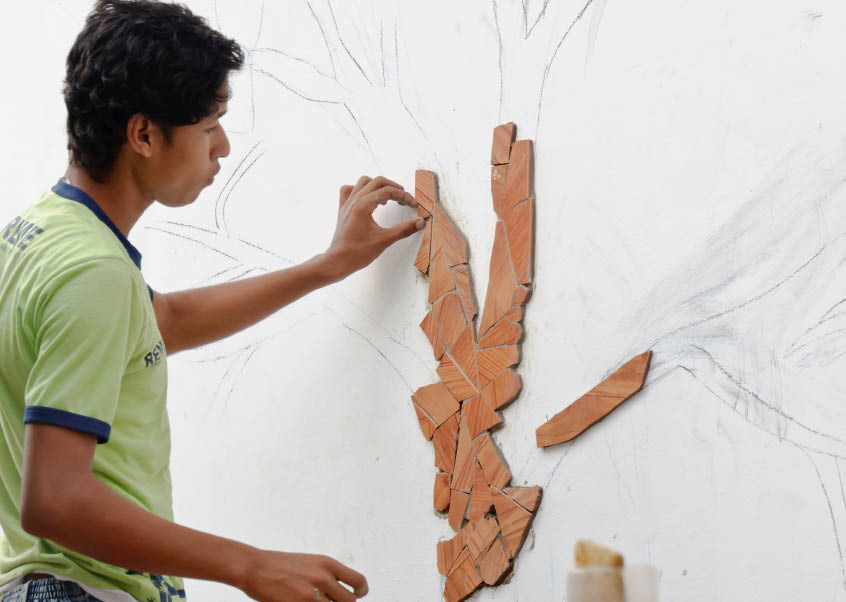
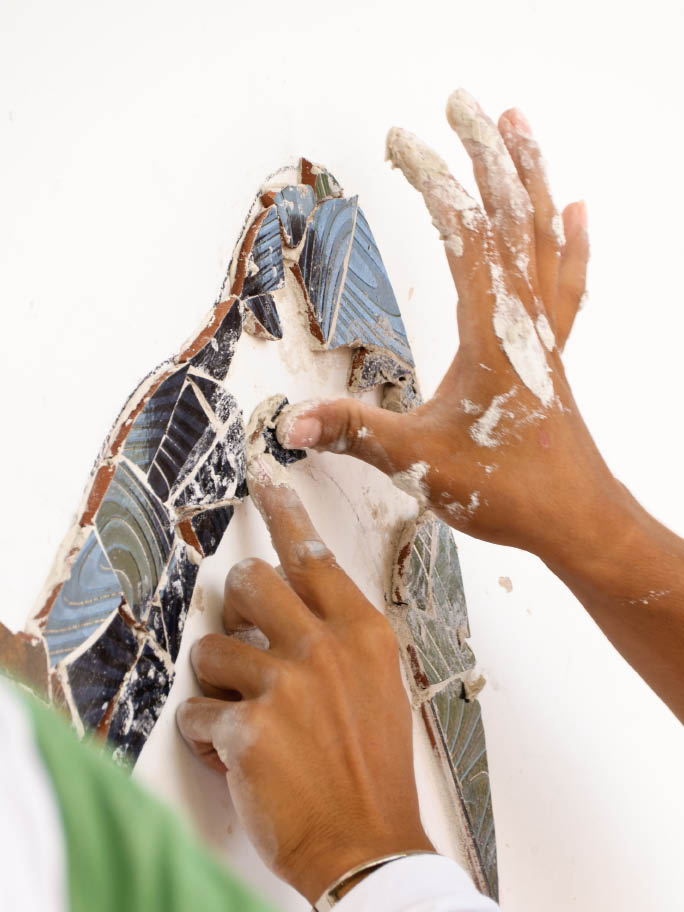
Trabalho
É com grande satisfação que os adolescentes do Projovem vem agradecer a oportunidade oferecida em aprender a técnica de mosaico em cerâmica. Nestas semanas vão ficar na memória dos que participaram, pois foram momentos de amizade, aprendizado respeito, e descoberta de talentos.
Com coragem e determinação, a cada dia a Projovem Adolescente deseja modificar a vida desses adolescentes tornando—os multiplicadores e protagonistas de sua própria vida. Com a técnica mosaico (pedrinhas humanas) é possível resgatar e desperta a criatividade, os sonhos e a cidadania dos jovens.
Aurice A B Romero, Psicóloga—Projeto Projovem, Corumbá
Working
The teenagers of Projovem greatly appreciated the opportunity to learn the technique of ceramic tile mosaics. These weeks will remain in the memory of those who participated because they were moments of friendship, respect for learning, and discovery of talents.
With courage and determination, every day Projovem wants to change the lives of these teens giving them strength to make them the protagonists of their own lives. With the mosaic technique (of human pebbles) it is possible to recover and awaken the creativity, the dreams, and the citizenship of these young people.
Aurice A B Romero, Psychologist—Project Projovem, Corumbá
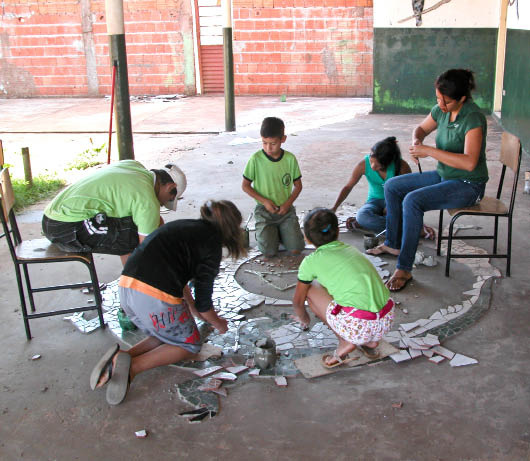
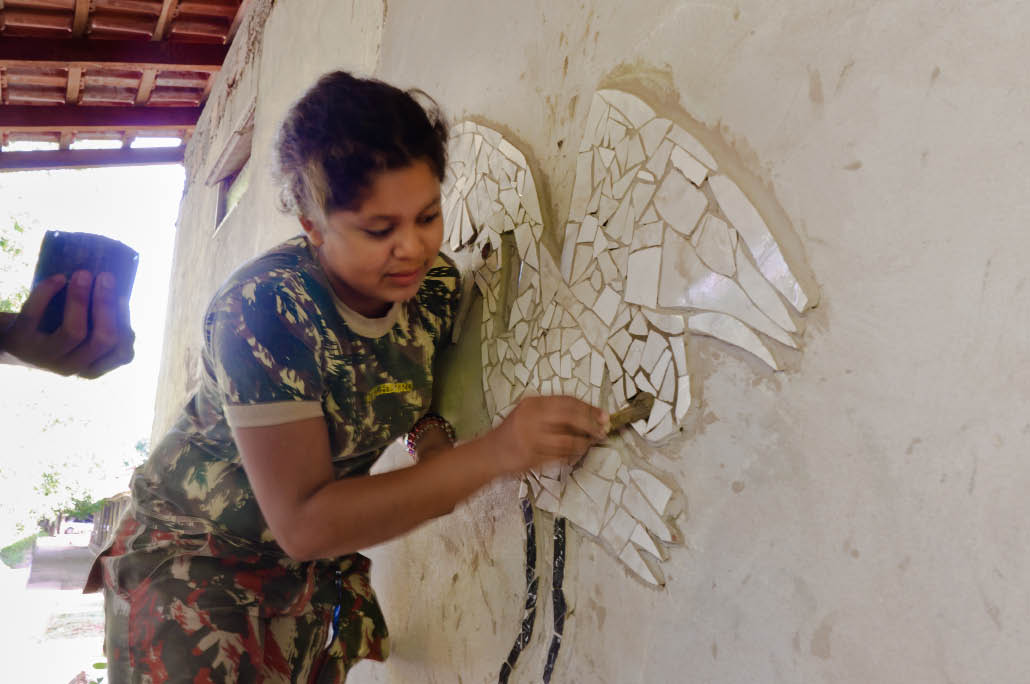
Saber valorizar as coisas, como o mosaico: Você pega uma pedra e pode fazer um piso, jogar e fazer um desenho. Aqui tem várias cerâmicas que são jogadas fora e ninguém aproveita. O mosaico é uma forma de aproveitar o desperdício desses materiais.
Learn to value things like the mosaic: You take tile and can make a stone floor, or play and make a picture. Here are tiles that are thrown away and no one takes advantage of that. The mosaic is a way to stop wasting these materials.
Também seria importante porque é possível pra gente fazer em casa e mostrar para outros pessoas o que a gente aprendeu aqui. Então eu acho que é muito importante para a gente aprender aqui, e mostrar para outras pessoas que tenham interesse.
It also could be important because it’s possible for us to do at home and to show other people what we learned here. So I think it’s very important for us to learn here and show other people who have an interest.
Quero ser um grande pintor, um pintor de murais.
I want to be a great painter, a painter of murals.
A arte é importante na vida de todo mundo; já vive com a arte.
Art is important in everyone’s life; we are already living with art.
A parte mais simples foi colar a argamassa.
The easiest part was using the mortar.
Porque sem arte é como que desde o princípio. Deus fez um mundo como uma arte. Como que ele foi criar as coisas, como que fez as cores, como que fez as coisas. Como que criou um mundo com arte, criando arte cria inova as coisas. Sempre quer avançar um pouco mais no que já sabe já.
Because without art it’s like it was at the beginning. God made the world as a work of art. As he was creating things, like he made the colors, like he made the things. Like making a world with art, and art creates art and innovative things.Always strive to go a little further than what is already known.
Ah, as peças que tem que colar com cuidado. Tem umas partes que a gente não acha, tem que procurar, quebrar, para...para fazer.
Ah, the pieces that you have to attach carefully. There are some pieces that we don’t find, we have to search for, break, to...to make it.
Sem a arte nós não tínhamos dom. Não tinha como expressar nossos dons né?
Without art we had no way. There was no way to express our talents right?
Arte é importante para mim por que no momento que eu estou ali concentrado naquilo a gente fica sem suspensa para terminar rápido para que depois que terminei para ver o trabalho pronto. A obra de arte é como uma expectativa quando você esta fazendo algo e você quer ver aquilo pronto. Para mim é arte.
Art is important to me because while I am there I am focused on what we are doing without wanting to finish quickly so that after I finish I can see the finished work. The art work is like an expectation when you’re doing it and you see it when it’s done. For me it’s the art.
Eu pense que é super legal. A gente pegar desde o começo as coisas e criar, é bem legal.
I think that it’s super cool. We start putting things together and things are created. It’s really cool.
Muitas pessoas passam na rua e vêem que é um trabalho muito bem feito, aí eles ficam admirando o trabalho de mosaico. Sim, acho que as pessoas deveriam valorizar um pouquinho o mosaico. Os símbolos mais importante para nós são a arara e a onça pintada. As pessoas gostam muito dos animais que tem na mata, aí eles podem fazer os mosaicos em suas casas.
Many people pass by on the street and see that it is a job well done, they admire the mosaic work. Yes, I think people should find value in the mosaics. The symbols most important to us are the macaw and the jaguar. People love the animals in the forest and can make the mosaics in their homes.
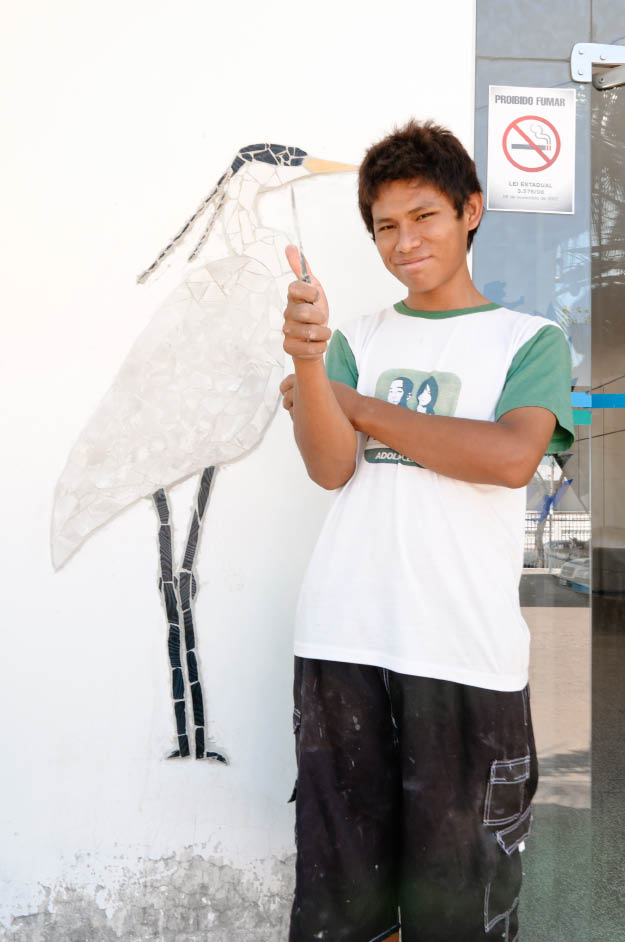
Terminou
Excelente, muito bom. Porque as a crianças se interessaram, tomaram gosto, e na minha visão eles fizeram um trabalho muito bom com o auxilio de vocês. E os alunos se eles tiverem mais interesse, é uma profissão muito linda. É que precisa ser valorizada.
Essas crianças elas foram escolhidas pelo grupo de professores da escola por terem um bom desenvolvimento na sala de aula. Elas são estudiosos, tem notas boas, são como crianças normais, que gostam de brincar, mas se sentem fazem o que deve de ser feito. Então é muito bom.
Essas que estão aqui a maioria delas querem ir para a universidade ou fazer um curso profissionalizante. Eu perguntei para eles e um quer ser veterinário, o outro pediatra. Como tem um menino que é boliviano eu perguntei a ele qual profissão gostaria de ter, e ele disse que quer ser advogado, a mãe gostaria que ele fosse médico, a irmã engenheiro. Mas o pai é borracheiro e quer que ele para trabalhar em sua oficina de borracharia. Então ele falou que esta difícil para decidir o que ele quer para o futuro. Então é difícil porque eles vão normalmente pela vontade dos pais, que é a figura maior dentro de uma casa. E assim condições para eles fazerem uma faculdade eles tem sim, então depende muito do encaminhamento familiar.
Lucilina da Costa Cunha, Professora—CAIC II, Corumbá
Finished
Excellent, really good. Because the children were interested, took to it, and from my point of view, they did a very good job with your help. And, if the students have more interest, it is a very beautiful profession. It needs to be valued.
These children were chosen by the teachers because they were doing well in the classroom. They are good students, have good grades. They are normal kids who like to play but do what they feel must be done. So, it is very good.
Most of those who are here want to go to college or a professional course. I asked them and one wants to be a veterinarian, another a pediatrician. We have a boy who is Bolivian and I asked him what profession he would like to have. He said he wants to be a lawyer, his mother would like him to be a doctor, his sister an engineer. But his father wants him to work in their tire repair shop. Then he said that it is hard to decide what he wants for the future. It’s hard because usually they go by the wishes of the parents since they are the larger figure within the home. So, the conditions are there for them to go to college but so much depends on the path of the family.
Lucilina da Costa Cunha, Professor—CAIC II, Corumbá
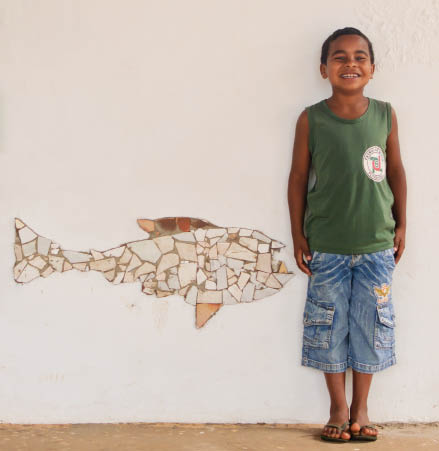
Meu sonho para o futuro é formar-me.
My dream for the future is to graduate.
Meu sonho para o futuro e fazer faculdade.
My dream for the future is to go to college.
Ah, o que nós aprendemos foi que a gente pode aprender qualquer coisa assim, fazendo as coisas. Como temos um monte de piso. Pode, olha, tudo que a gente quiser a gente pode fazer. A gente pode ter o nosso sonho.
Ah, what we learned was that we can learn many things as we are doing this. Like you have a stack of tiles. You can, look, you can create whatever you want. You can have your dream.
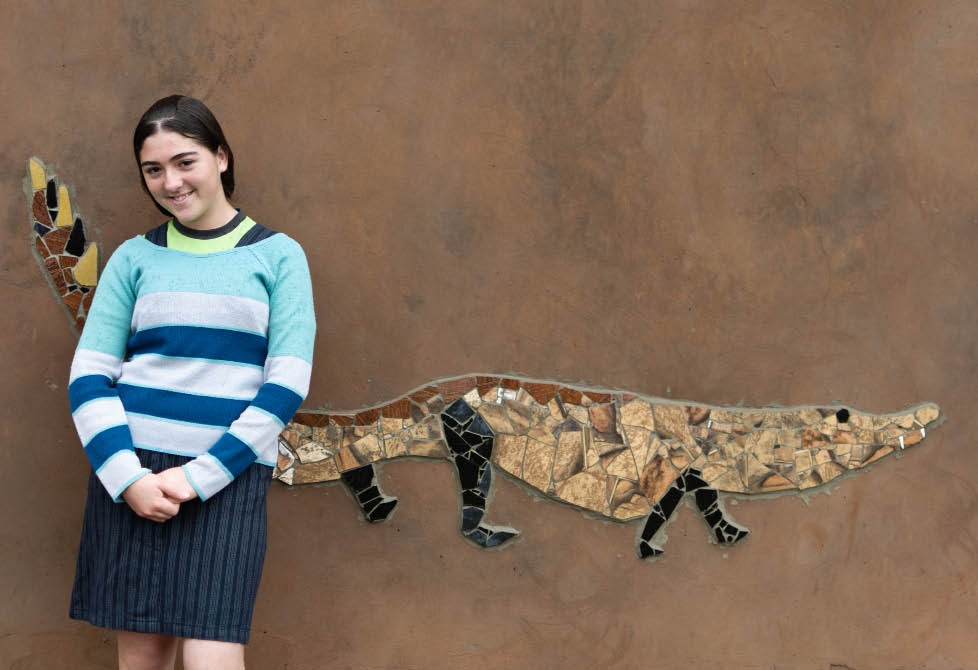
É um pouco difícil de fazer, mas é legal fazer o mosaico. É tipo xadrez. É preciso muita concentração. Tem que ter muita calma porque cada piso se não der certo tem que ir atrás de otro piso. Se você colar uma peça errada já asneira tudo. Tem que tirar para fazer de volta. Muito legal fazer o mosaico. Quando eu crescer eu quero fazer mosaicos porque é muito legal fazer mosaico. Ensinar meus filhos, meus colegas.
It’s a little hard to do, but it’s cool to do the mosaic. It’s like chess. It needs a lot of concentration. We need to be very calm because you never know if each tile will follow another tile. If you paste a piece wrong, everything is screwed up. You have to take it off and do it again. When I grow up I want to do mosaics because it’s very cool to make mosaics. Teach my children, my friends.
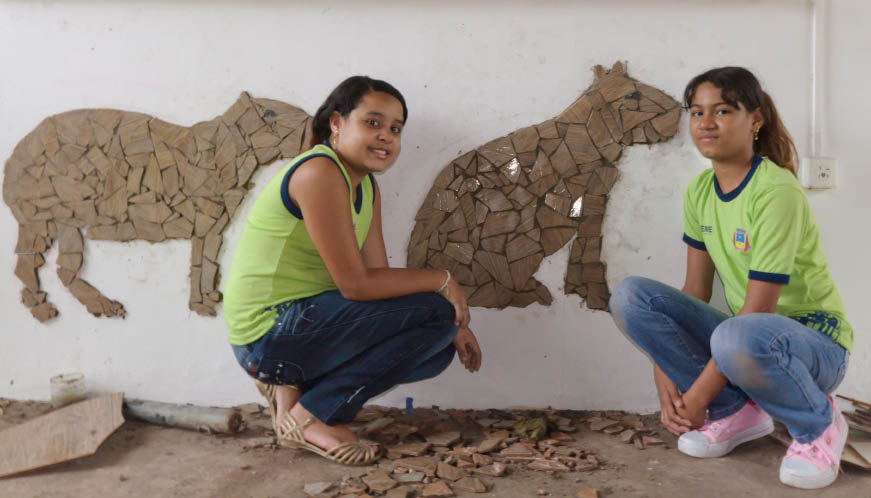
E para mim mudou muito—uma coisa assim nova. Quando falou assim mosaico eu não sabia o que era o mosaico. Como assim o mosaico? O mosaico é aquilo e tal. Depois que eu cheguei aqui eu achava que era uma forma, mas quando vi que era uma parede que a gente tem que montar tudo certinho, falei, “meu Deus do céu, o que é isso?!” Eu nem sei o que é isso, mas depois fui arrumando, a gente foi pegando gosto pela coisa e foi entendendo o que é o mosaico, aprendendo também mas um pouco sobre a arte. Isso, então para mim foi um projecto muito legal. Então, para mim foi uma experiência maravilhosa.
And a lot has changed for me—this is a new thing. When you told us about the mosaic I didn’t know what it was. What do you mean, mosaic? A mosaic is this and that. When I got here I thought that it was a technique but when I saw that it was a wall and that we had to make it just right I said, “My God in heaven, what is this?!” I don’t know what it is. But then I was getting started, we were getting the feel of it and understanding what a mosaic is, and learning a little more about art. Then, for me this was a very cool project. So, for me it was a wonderful experience.
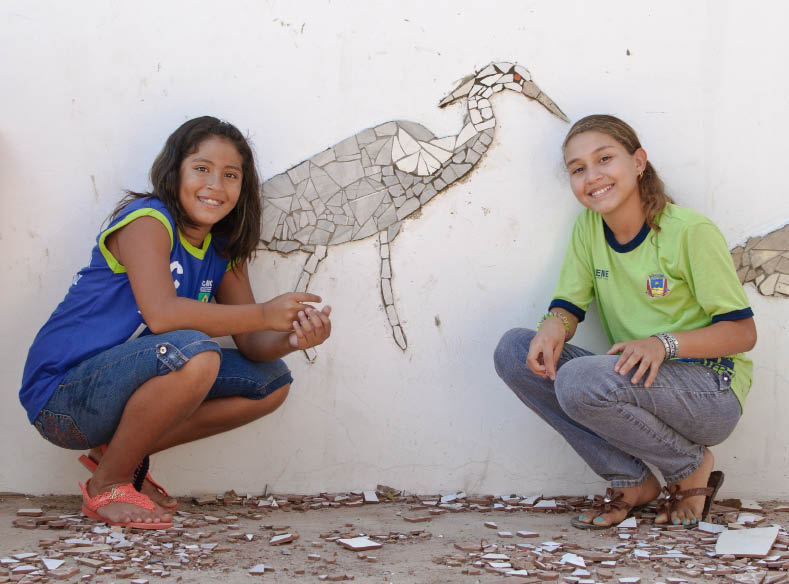
Mosaico é muito bom, gostei, muito legal essa arte, eu não sabia. Eu gostei muito do mosaico. É uma idéia legal, é bom que se distrai, usando as pecas. Eu nem imaginei que ia ter coisas assim de quebrar e fazer. Essa técnica é muito, muito importante. Acho que muitas pessoas iam querer, é uma arte muito gostosa, eu gostei muito.
The mosaic is really good, I liked it. This art is really cool, I didn’t know. I really enjoyed the mosaic. It is a cool idea and it’s fun to put the pieces together. I never imagined that I would have stuff like this to break and to do. This technique is really, really important. I think lots of people would want to do it. It is a really nice art, I really enjoyed it.
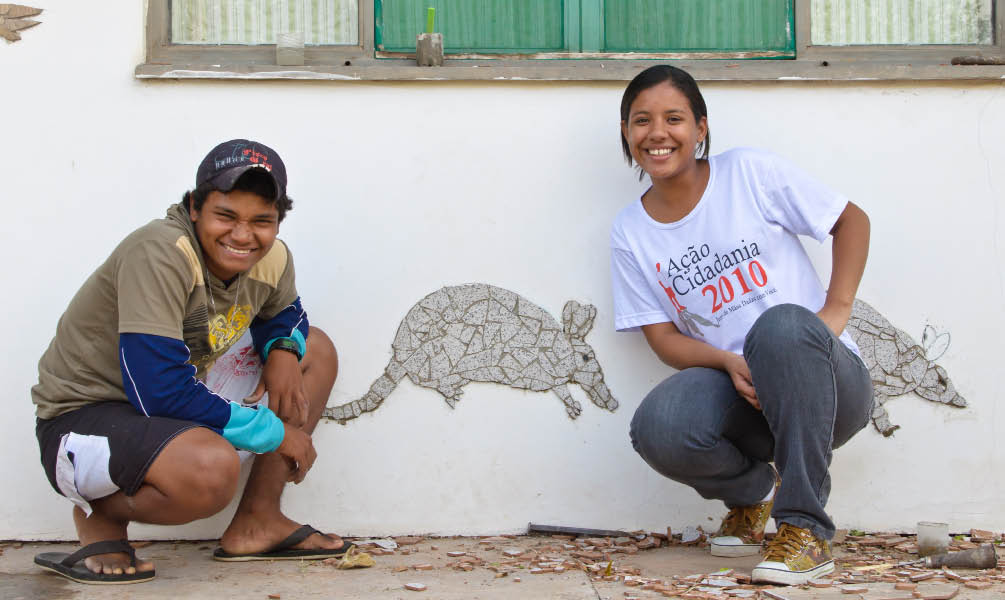
Quando as pessoas vêem eu vou me sentir mais ou menos privilegiado por que eu posso dizer que fui eu que fiz. Eu posso dizer que vou mostrar para eles. E, quem sabe, podem estar interessados, pegar a técnica e podem fazer até em casa.
When people see it I will feel pretty proud that I can say that I made that. I can say that I will show it to them. And, who knows, they could be interested, pick up the technique, and they can even make them at home.
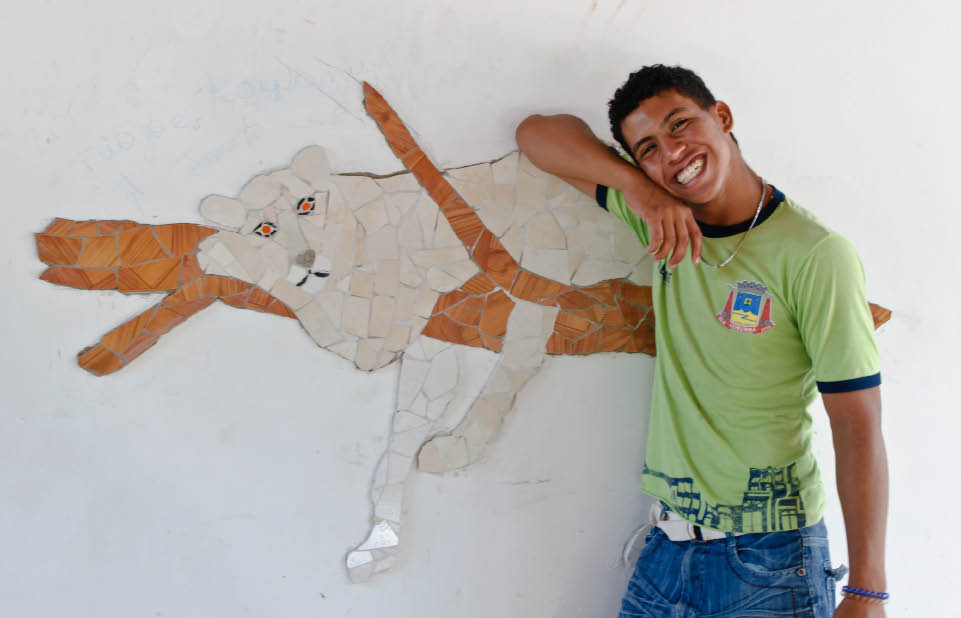
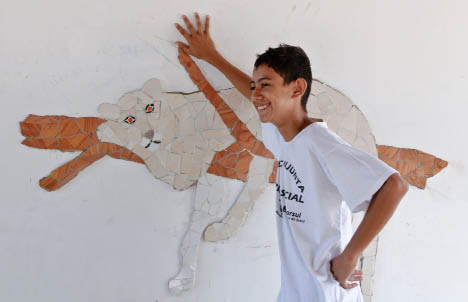
Gostei do desenho e as telhas o melhor. Foi legal para fazer as peças se encaixam. Foi interessante para torná-lo em um peixe. Eu gosto de desenhar e aprendi um monte de coisas a fazer os mosaicos, puxando os animais. A parte mais difícil foi fazer o bico do tuyuyu. Acho que a arte é importante porque é legal para pintar e arte é interessante. O Brasil tem um monte de arte. São Paulo tem um museu. Eu não estive lá, mas eu vi na televisão e foi muito interessante. As pinturas, muito legal.
I liked the drawing and the tiles the best. It was cool to make the pieces fit. It was interesting to make it into a fish. I like to draw and I learned a lot of things doing the mosaics, drawing the animals. The hardest part was making the beak of the tuyuyu. I think art is important because it’s cool to paint and art is interesting. Brazil has a lot of art. Sao Paulo has a museum. I haven’t been there but I saw it on television and it was very interesting. The paintings, really cool.
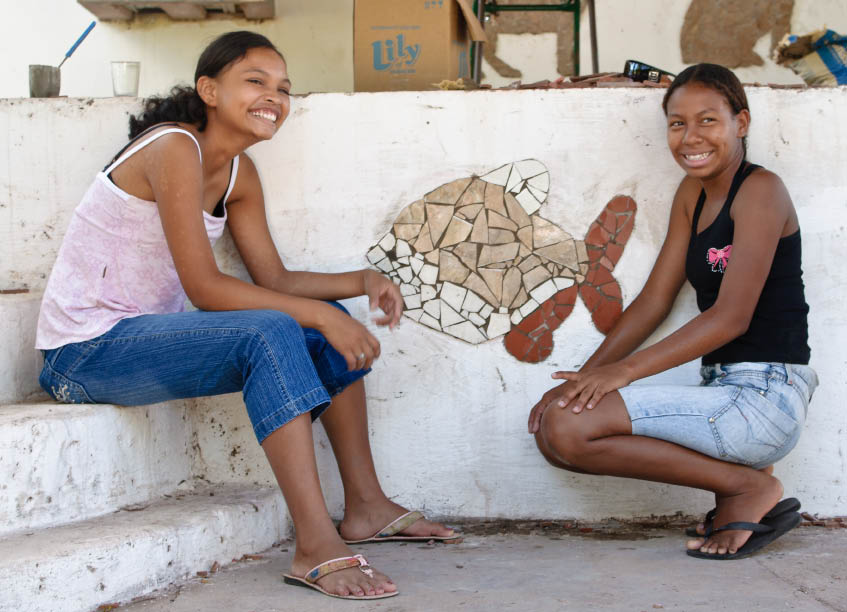
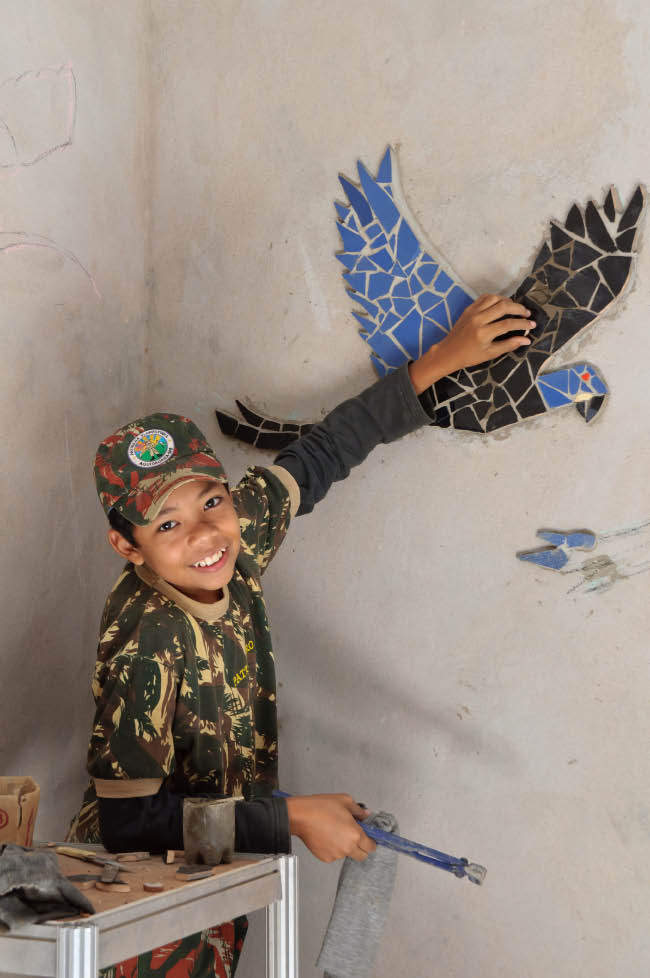
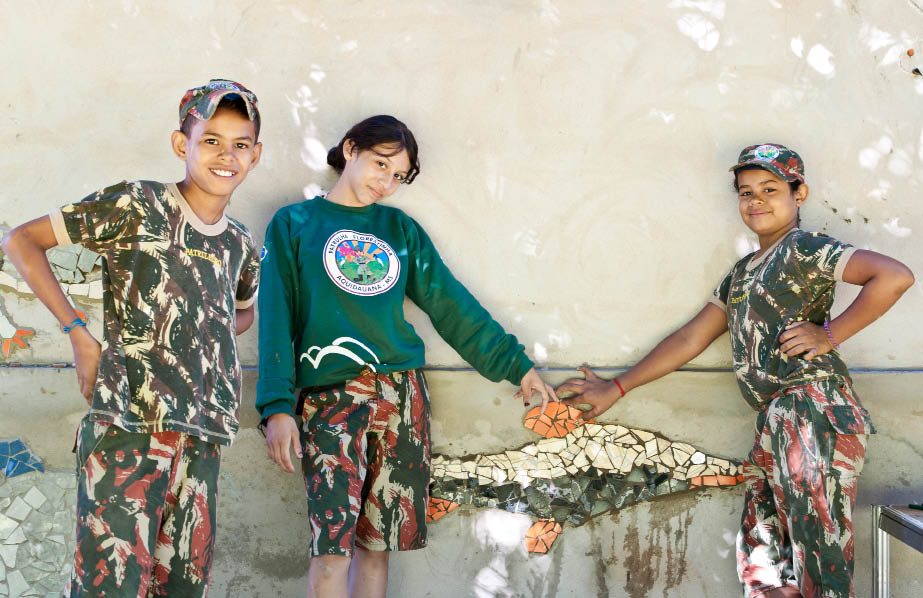
Minha matéria preferida na escola é matemática. Eu gosto de pular corda. Meu sonho é ir para a faculdade e eu quero estar na PMA. Eu gosto dos mosaicos, porque aqui no Brasil nós não sabemos essas coisas, e com isto o Brasil é mais bonito.
My favorite subject in school is math. I like to jump rope. My dream is to go to college and I want to be in the Environmental Police. I like the mosaics because here in Brazil we don’t know these things, and with these Brazil is more beautiful.
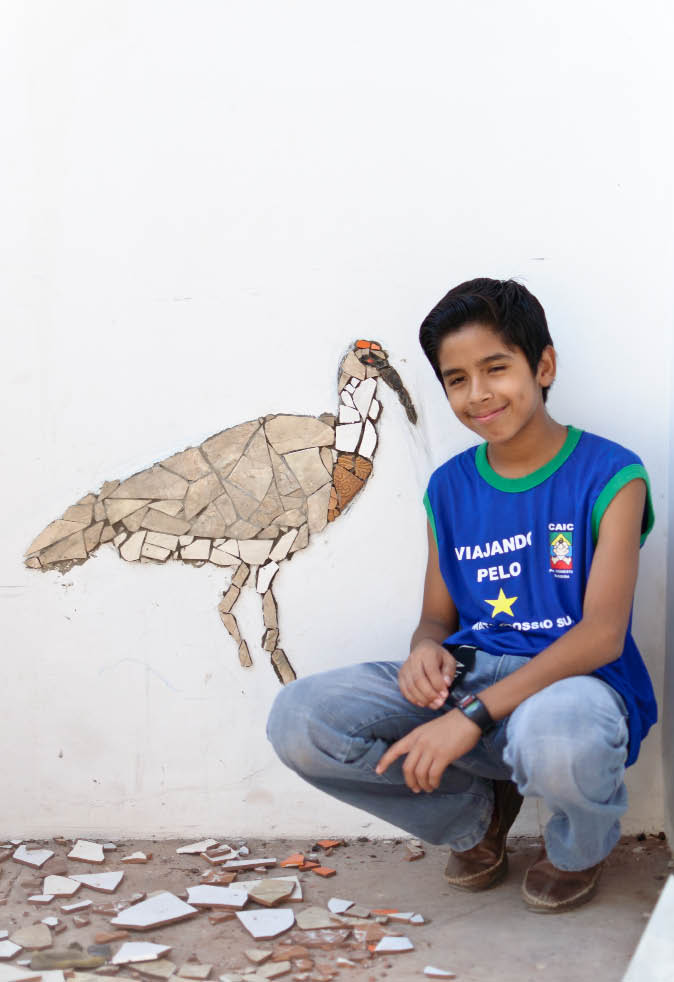
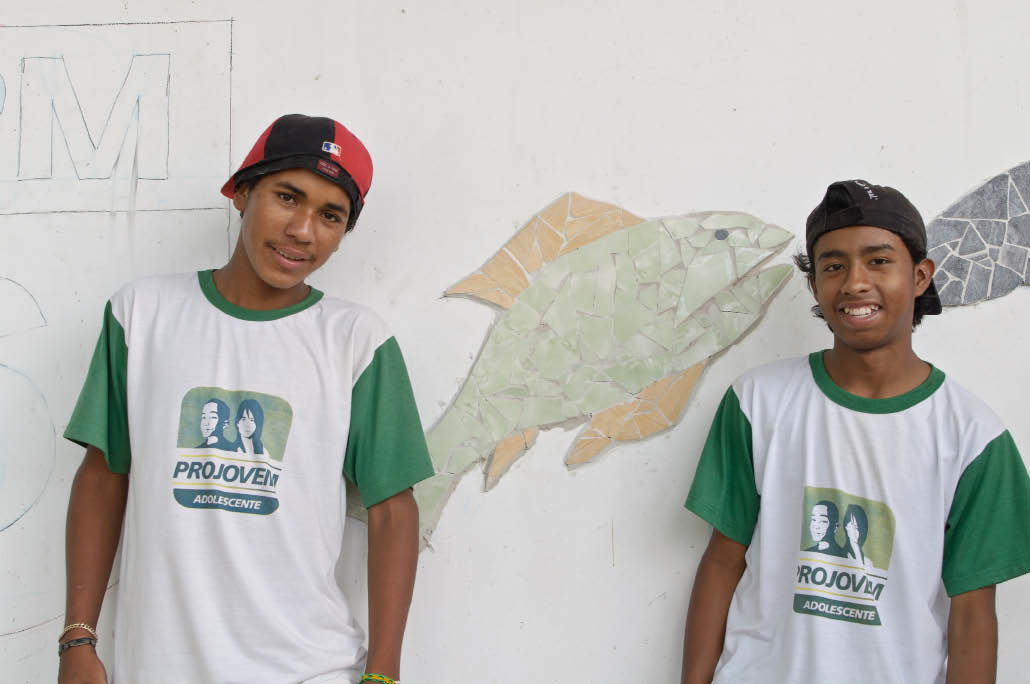
Arte é importante por causa do conhecimento. Você desenha, viaja e aprende muita coisa. Coisas que você nem sabia, você faz, como o mosaico. Eu queria aprender e poder viajar assim para longe, conhecer cidades, conhecer outra línguas. As únicas línguas que eu conheço são português, inglês e espanhol. Nunca ia imaginar na minha vida que eu ir iria fazer isso.
Art is important because of knowledge. You draw, travel, and learn a lot. You do things you never knew you could do, like the mosaic. I would like to learn and be able to travel far, get to know cities and other languages. The only languages I know of are Portuguese, English, and Spanish. I would never in my life imagine that I could go do that.
Temos de ser gentis com as crianças e para incentivar as pessoas para fazer mosaicos para enfeitar a cidades.
We need to be kind to children and to encourage people to make mosaics to decorate the cities.
Bom, mosaico para mim é uma obra de arte, e uma coisa que eu valorizo muito. E que é uma coisa bonita e uma nova técnica que eu aprendi, uma nova coisa que o futuramente posso estar passando de de um para outro: Pra meus pais, meus irmãos e até para meus filhos.
Well, the mosaic for me is a work of art, it is a thing that I value greatly. It is a beautiful thing and a new technique that I learned, a new thing that in the future can be passed from one to another: To my parents, my brothers, and even my children.
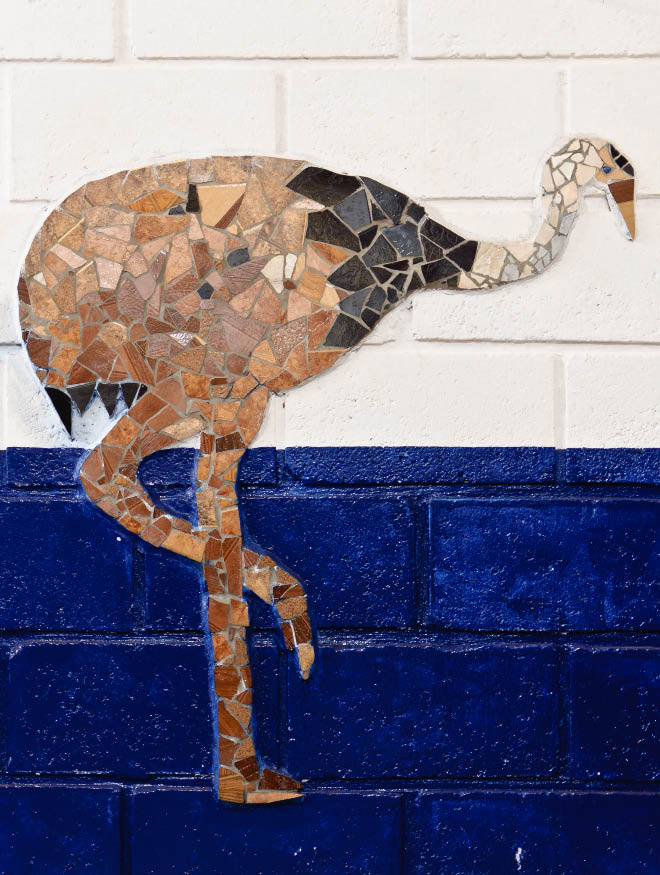
O Meio Ambiente
O Pantanal é uma região naturalmente alagada no centro da América do Sul. Situada ao sul da região amazônica, a maior parte de seus 230.000 km2 pertence aos estados brasileiros de Mato Grosso e Mato Grosso do Sul, o restante se estende pelas regiões leste de Bolívia e Paraguai. Com estações de chuva e seca, este sistema de terras baixas funciona como uma esponja controlando as cheias e o recuo das águas de seus dois rios principais—Paraguai e Taquari. Este movimento das águas promove a renovação de nutrientes, purificação e armazenagem nos lençóis freáticos.
A região abriga centenas de animais. Sentados às margens do rio Paraguai, fomos agraciados pela visão de dezenas de espécies de aves, desde os minúsculos periquitos verdes aos Martin Pescadores de topete, ao altíssimo e elegante Tuyuyu, ave-símbolo do Pantanal.
Fomos visitados por ariranhas, macacos, jacarés, sapos e insetos. Em outras regiões assistimos às capivaras, o maior roedor do mundo, pastando despreocupadas entre um rio e outro, sempre descansando enquanto trilhavam seus caminhos. Nós vimos tucanos, tamanduás, sucuris, antas e veados. Ouvimos o som profundo e intenso do chamado dos bugios carregar o ar, o coaxar dos biguás enquanto aninhavam ao anoitecer, e as araras que gritavam seus nomes “arara, arara!” Nós comemos mamão, manga, caju, coco, e muitas outras frutas cujos nomes jamais saberemos, colhidas à porta, nas ruas e ao longo dos caminhos. Fomos cercados por árvores e flores que víamos apenas como ornamentos e em arranjos feitos por floristas na Nova Inglaterra. E nós ouvimos incontáveis histórias de aparições de onças e lobos guará.
O povo do Pantanal depende da terra para criar o gado, os cavalos e emas; para o cultivo, a pesca e turismo.
Infelizmente, há também caça e tráfico de animais silvestres, mineração, pesca predatória e o uso de agrotóxicos que comprometem a saúde da região. Fomos abençoados em trabalhar com cidadãos, a polícia ambiental, governantes locais e ver o trabalho que eles, e outros, têm feito para educar, legislar e proteger essa região tão bela.
The Environment
The Pantanal is a pristine wetlands in the center of South America. Situated south of the Amazon region, most of its 54,000 sqare miles are in the Brazilian states of Mato Grosso and Mato Grosso do Sul, the rest extending into the eastern parts of Bolivia and Paraguay. With its wet and dry seasons, this lowland system acts like a sponge to help control flooding of its two main rivers, the Paraguay and Taquari, and stores and purifies ground water and nutrients.
The region is home to hundreds of species of animals. Sitting on the banks of the Paraguay River we had the good fortune to see dozens of bird species from tiny green parakeets to fringe headed kingfishers to tall and regal Jabira storks—the symbol of the Pantanal.
We were visited by giant river otters, monkeys, alligators, frogs, and insects. In other parts of the region we watched families of capybaras, the largest rodents in the world, graze slowly across from one river to another, resting frequently as they made their way. We saw toucans, anteaters, anacondas, tapir, and deer. We heard the air fill with the huge, deep calls of howler monkeys, the croaking of cormorants as they nested in the evenings, and the macaws coarsely crying out their Portuguese names “arara, arara!” We ate papayas, mangos, cashew fruits, coconuts, and many other fruits whose names we never knew, picked from trees outside our door, along the streets and paths. We were surrounded by flowers and trees that we only see as houseplants and florist’s arrangements in New England. And we heard countless stories of jaguar and maned wolf sightings.
The people of the Pantanal depend on the area for cow, horse, and emu ranching; farming, fishing, and tourism.
Unfortunately, there is also poaching and animal trafficking for profit, mining, over-fishing, and agrochemicals that threaten the health of the area. We were fortunate, in our work with individuals, the environmental police, and town governments to see the work that they, and others, are doing to educate, legislate, and watch over this beautiful region.
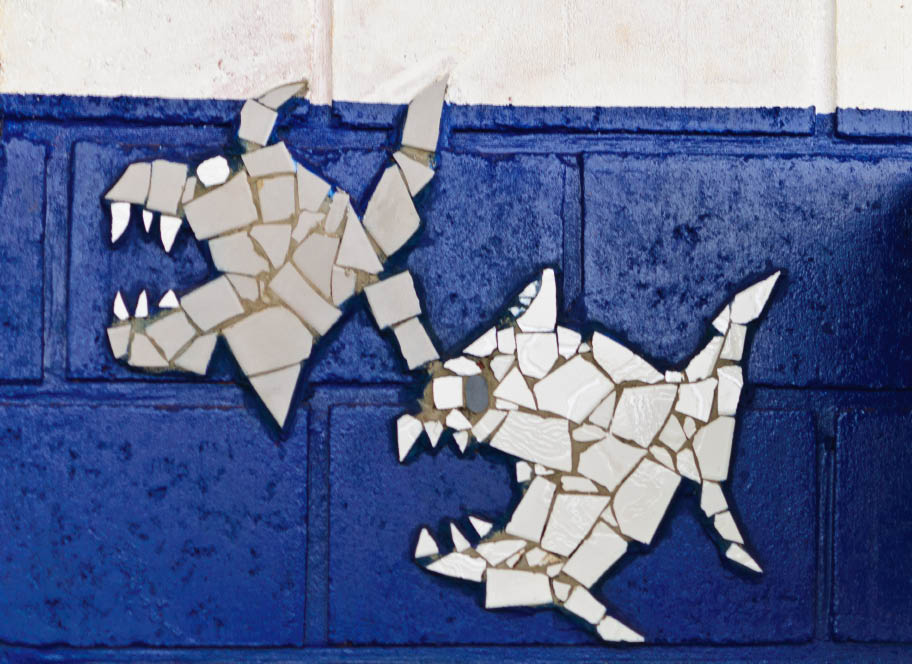
O mosaico marcou assim, muito bem pelo nosso projecto. Nosso projecto é sobre isso. É criar a Florestinha e falar sobre o meio ambiente. A gente faz o mosaico dos animais porque é uma das parte Pantanal. Nós decidimos fazer peixe e o jacaré em homenagem aos nosso colegas, mesmo aqueles que não vieram.
The mosaics worked well for our project. Our project is about this. The Florestinha is created and talks about the environment. We are making the mosaic of the animals because they are part of the Pantanal. We decided to do fish and an alligator as a tribute to our friends, even those who couldn’t come.
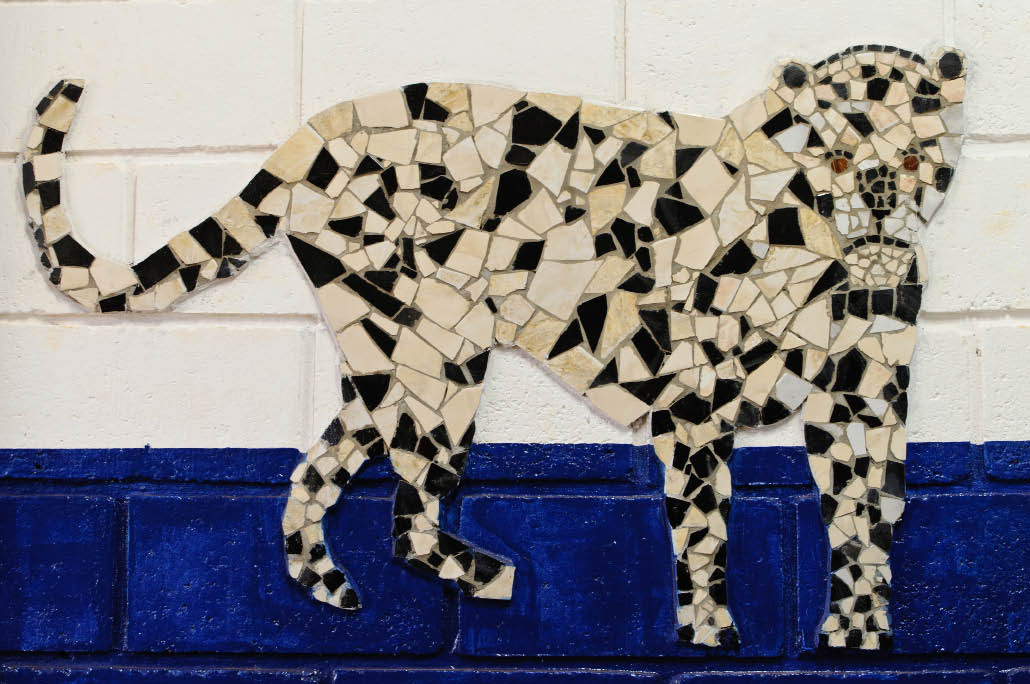
Isso não tem opção tenho que fazer alguma coisa relacionada a meio ambiente. Assim salvar alguns animais de extinção. Os animais com risco de desaparecer. Então alguma coisa relacionada com o meio ambiente talvez seja uma boa opção.
There is no option, I have to do something related to the environment. Save some animals from extinction. Animals are at risk of disappearing. So, something related to the environment might be a good option.
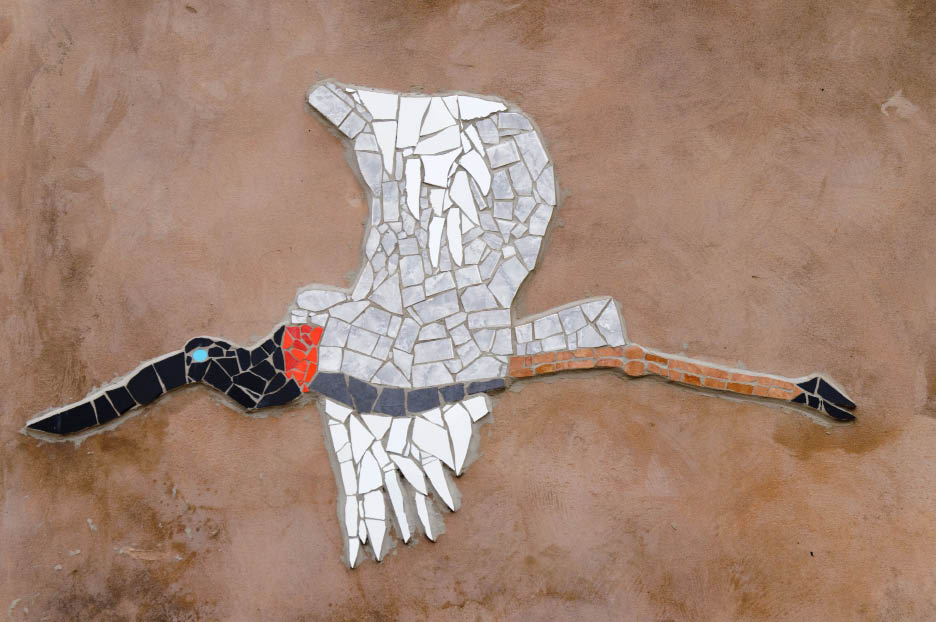
Aqui no nos estado de Mato Grosso do Sul com meio ambiente a natureza um dos bem mais preciosos nossa região. Porque aqui a maioria dos pessoas vive na natureza, vivem da pesca, do artesanato que nos da. Argila ven das águas do Rio Paraguai. As pessoas um meio ambiente tem que ser preservado. Porque sem ela nada existia. As pessoas não saberiam viver aqui se não tivessem árvores no planeta. Como que as pessoas iam respirar? As árvores somes que produzem a fotossíntese se eu não me engano. Como que as pessoas sobreviveriam na terra.
Here in the state of Mato Grosso do Sul the environment and nature is one of the most precious in the region. Because most people here live in nature, survive on fishing, on the crafts that are here. Clay comes from the waters of the Paraguay River. The people have an environment that must be preserved, because without it nothing would exist. People would not know how to live without trees on the planet. How would people breathe? The trees are needed for photosynthesis if I’m not mistaken. That’s how people survive on the earth.
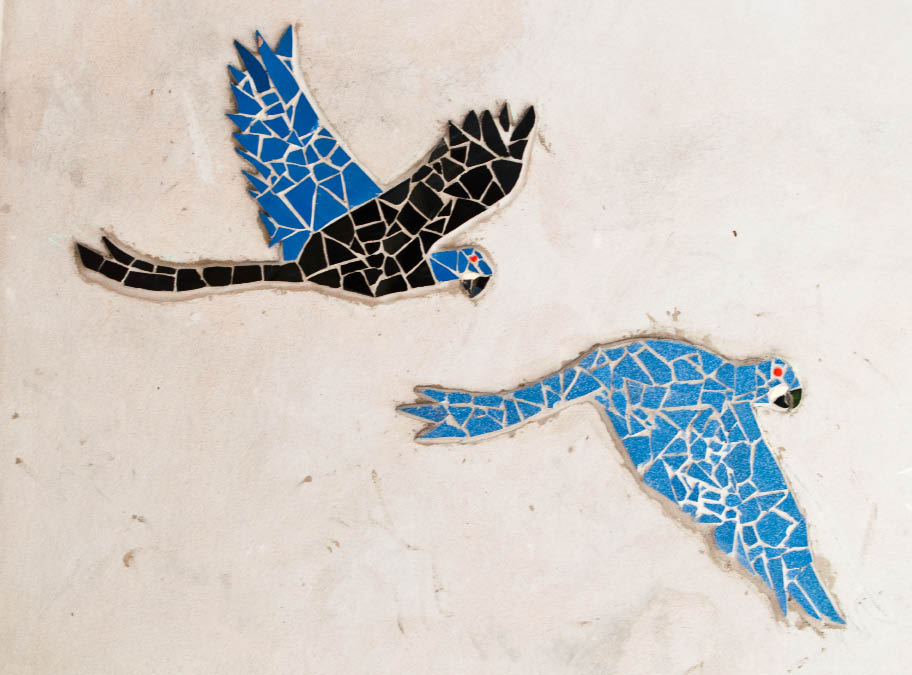
O Brasil é especial porque tem o Carnaval e as festas tradicionais. Há diversas tradições e todas elas são parte da cultura. A tradição aqui é o “pantaneiro”, no nordeste é “nordestina”. Aqui em Rio Verde, temos uma natureza deslumbrante e não muita poluição.
Brazil is special because it has Carnaval and traditional festivals. There are various traditions and they are all part of the culture. The tradition here is the “pantaneiro”, in the northeast it’s “nordestina”. Here in Rio Verde we have beautiful nature and not much pollution.
Expressar a nossa cultura porque a gente pode mostrar um pouco do Pantanal. Mostrar cada uma das nossas espécies do Pantanal.
It expresses our culture because we can show some of the Pantanal, show each of the species of the Pantanal.
Há belezas naturais. A água é pura, em alguns países não tem agua, mas aqui no Brasil tem água de sobra, é até desperdiçada.
There is beautiful nature. Water is pure, some countries do not have water, but here in Brazil there is plenty of water, until it is wasted.
Eu acho que eu penso muito mais sobre as crianças que vêm ver os mosaicos. Porque o adulto vai olhar e dizer, “Nossa! Que interessante.” Mas, as crianças, não. Elas dizem, “Nossa! Que legal! Um pássaro!” E, depois, como a criança, o adulto vai olhar e dizer, “Nossa! Isso é uma obra de arte!”
I guess I think a lot more about the children who will come see the mosaics. Because adults will look and say, “Wow! That’s interesting.” But the kids, no, they say, “Wow! Cool! A bird!” And after that, like the child, the adults will look and say, “Wow! This is a work of art!”
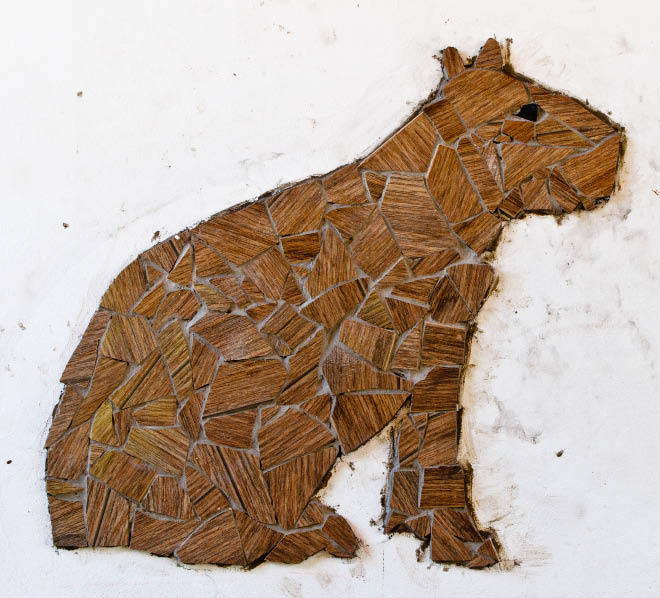
Aqui no Brasil o que se tem é um pais economicamente forte. A gente tem que buscar alternativas que a gente possa usar para nosso próprio bem. Assim plástico e metal tenta fazer objectos que vão valer a pena. Reciclar, tenta reciclar. Não desmatar floresta.
Here in Brazil we can have an economically strong country. We have to find alternatives that we can use for our own good. So plastic and metal have to be used for things that are worthwhile. Recycle, try to recycle, not to deforest.
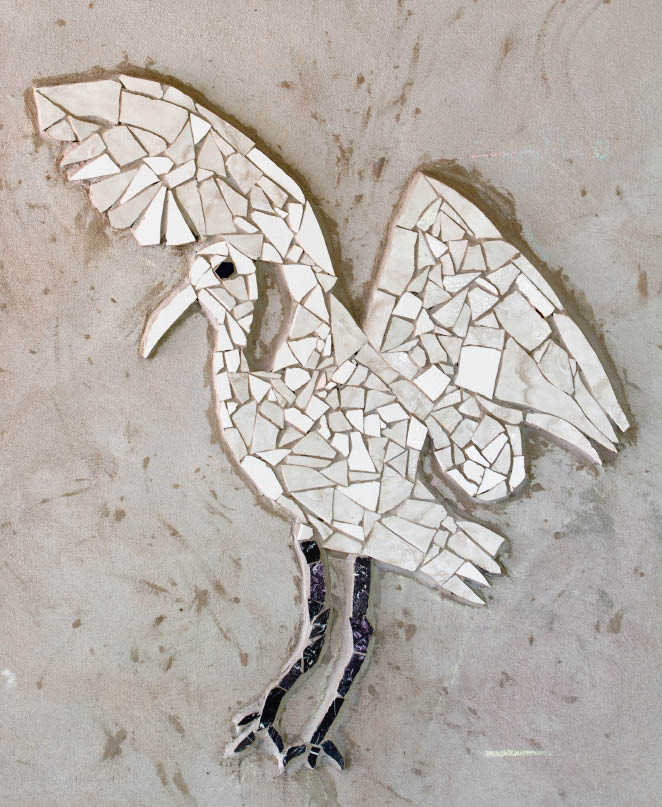
Eu queria fazer a flor, o castelo, e Michael Jackson, porque eu pensei que eles eram legais. Minha coisa favorita na escola é arte e eu sou bom em desenhar roupas. Eu também gosto de dançar. Quando eu crescer, meu sonho é me formar no ensino. Eu quero ser um professor e desenhar roupas para as pessoas. Eu pensei que o projecto do mosaico foi legal. Eu aprendi que ser um artista faz a diferença. A arte torna o mundo tem mais cores e desenhos.
I wanted to make the flower, the castle, and Michael Jackson because I thought they were cool. My favorite thing in school is art and I’m good at drawing clothes. I also like to dance. When I grow up my dream is to graduate from school. I want to be a teacher and to design clothes for people. I thought the mosaic project was cool. I learned that being an artist makes a difference. Art makes the world have more colors and drawings.
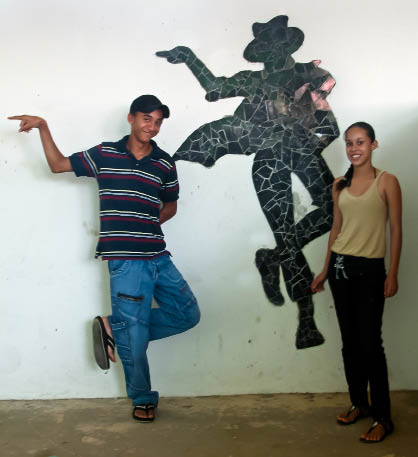
Dança
No Instituto Mirim, na cidade de Rio Verde, nós começamos trabalhando em mosaicos de animais em uma sala bastante ampla, em seguida trabalhamos na representação de um capoeirista e de um esqueitista em duas das salas menores. As crianças falavam muito sobre Michael Jackson e reproduziam alguns de seus passos de dança. Havia também um professor que lhes ensinava hip-hop, algo no qual eram muito boas. Resolvimos então fazer esboços de imagens de Michael Jackson nas paredes da sala que seria usada para as aulas de dança. As crianças fizeram um excelente trabalho criando um mosaico a partir dos traços.
As crianças criaram e executaram seu próprio mosaico no lado externo da sala, que batizaram de “Carro do Hip-Hop”.
Dance
At the Instituto Mirim in Rio Verde we started doing mosaics of animals in the large main room and then worked on a capoierista and a skateboarder in two of the smaller rooms. The kids would constantly talk about Michael Jackson and do imitations of some of his moves. There also was a hip-hop class that one of the teachers taught and the students were really good. So we drew pictures of Michael Jackson on the walls of the room for dance classes. The kids did a beautiful job of creating the mosaics.
As Organizações
The Organizations
Projovem
Projovem é um projeto do governo federal, em parceria com a prefeitura municipal visando estimular o protagonismo desses adolescentes, que se tornam pessoas importantes dentro da comunidade, valorizar essas habilidades artísticas, mostrar com que eles se façam autónomos. Então tem vários objectivos que vão fazer que esses adolescentes amadureçam, que se desenvolvam, que desenvolvam várias habilidades e prepara eles para o mercado de trabalho. Outras actividades, eles tem palestras, tem oficina de dança, oficia de artesanato, aula de ténis, tem estágio no museu do Pantanal. Uns fazem curso de informática, outros de recepcionista.
Eles são adolescentes de famílias carentes, todos recebem bolsa família. Alguns vieram encaminhados do concelho tutelar (CREAS) ou outros orgãos que são responsáveis por proteger e garantir os direitos da criança e do adolescente. Então são adolescentes de famílias carentes que precisam dessa atenção. O governo tem essa visão pró social. CREAS é um centro para atender todo tipo de violência, se for violado, se a pessoa estiver sem o seu direito, ela então vai tentar agir. Ela os encaminha para os programas, e pode ser que encaminhem para mim alguns adolescentes que estejam em vulnerabilidade.
Aurice A B Romero, Psicóloga—Projeto Projovem, Corumbá
Projovem
Projovem is a project of the federal government in partnership with the city government to encourage these adolescents who will become important people within the community. It values these artistic abilities and shows them that they can be autonomous. We have several goals: That the adolescent matures, develops, develops various skills and is prepared for the labor market. There are other activities such as lectures, dance classes, a crafts shop, tennis lessons, internships at the Museum of the Pantanal. Some do a computer course, others study to be a receptionist.
They are teenagers from needy families. Each family receives public assistance. Some had been sent to protective services (CREAS) or other organizations that are responsible for protecting and guaranteeing the rights of children and teenagers. So, they are teens from poor families who need this attention. The government has this pro-social vision. CREAS works with all kinds of violence. It acts if someone’s rights are violated. It offers programs for people and the vulnerable teenagers come to me.
Aurice A B Romero, Psychologist—Project Projovem, Corumbá
Projeto Florestinha
O Projeto Florestinha é uma ação de fundamental importância social e ambiental da Polícia Militar Ambiental, que trabalha com crianças e adolescentes carentes de 07 a 15 anos, tirando-lhes das ruas, dando-lhes a chance de ter uma profissão e ensinando-lhes a serem cidadãos com consciência ambiental. Esse projeto iniciou-se em 23 de novembro de 1992, no município de Campo Grande, MS com 50 crianças, em instalações localizadas em uma reserva ambiental de 180 hectares, no bairro Jardim Presidente, denominada Matas do Segredo.
Em parcerias com os órgãos de assistência social as crianças recebem aulas de Educação Ambiental, reforço escolar e treinamentos ministrados por policiais ambientais. Os órgãos públicos de assistência social propiciam acompanhamento psicológico, odontológico, reforço alimentar, vale transporte e orientação profissional.
A partir de 2010 projetos foram implementados em 10 cidades. A idéia é atender 1.000 crianças em todo o Estado e, além de tirá-las das ruas e dar formação social e ambiental, também poder encaminhá-las profissionalmente
Todas as crianças que participam do projeto são carentes e, várias delas ficavam nas ruas, sujeitas às drogas e passíveis de adentrarem na vida criminal. Dessa forma, a preocupação do projeto também é encaminhar as crianças para serem cidadãos dignos e, encaminhá-los em uma profissão é fundamental para isso. A arte pode ser uma das chaves para aqueles que têm a vocação artística, mas que por falta de oportunidades não tiveram a chance de desenvolvê-la.
A partir de 2009 pudemos contar com a boa vontade do artista Robert Markey e Julie Orfirer, que voluntariamente, ofereceram-se para ensinar a arte em mosaicos com as crianças do Projeto. Em dois anos, vários deles aprenderam esta arte e desenvolvem agora trabalhos nas escolas e ensinam aos novos alunos do Projeto. A arte funciona também como uma terapia, influenciando na parte psicológica e melhorando o comportamento das crianças. Pelo menos, temos percebido isto com o desenvolvimento dos trabalhos artísticos. Portanto, pretendemos desenvolver ainda mais trabalhos desta natureza em todas as unidades do Projeto no Estado.
Capitão Ednilson Paulino Quiroz, Doutor em Ecologia—Policia Militar Ambiental
Florestinha Project
The Florestinha Project of the Environmental Police is a mission of great social and environmental importance. The project works with youth from seven to fifteen years, taking them from the streets, giving them the chance to learn a profession and teaching them to be environmentally conscious citizens. The project began on November 23, 1992, in Campo Grande, MS with fifty children in facilities in the Jardim Presidente neighborhood located in an environmental reserve of 180 hectares called the Secret Forest.
In partnership with the departments of social welfare, children are given help with their school studies and are also taught civics, environmental education, and environmental police training. The public social service agencies provide mental health counseling, dental care, food coupons, and professional guidance.
As of 2010 projects have been implemented in 10 cities. The idea is to serve 1,000 children throughout the state, taking them off the streets, making them aware of social and environmental issues, and giving them professional training.
All children participating in the project are poor, many of them living in the streets, subject to drugs and the possibility of entering into criminal life. A major concern of the project is to train children to be good citizens and direct them toward a profession fundamental to this. Art can be a key to those who have the artistic vocation, but for lack of opportunities have not had the chance to develop it.
Starting in 2009 we were fortunate to have artist Robert Markey and Julie Orfirer come to teach the art of mosaic to the children of the Project. In two years many of them learned this art and now work in the schools teaching new students of the Project. Art also works as therapy, influencing and improving the psychological behavior of children, and we have noticed this with the development of art projects. We therefore intend to develop further studies of this nature in all units of the Project in the state.
Captain Ednilson Paulino Quiroz, PhD, Ecology—Environmental Police
Instituto Mirim
Fundado em 10 de Março de 2009, IMRV Instituto Mirim de Rio Verde tem como objetivo principal preparar adolescentes das camadas populares para o primeiro emprego. Junto à preparação para o trabalho dá oportunidade ao adolescente a participação em diversas outras atividades com o propósito de reforçar o interesse dos mesmos pelos estudos e, consequentemente, o aprimoramento do pensamento crítico.
Além da constante preocupação com a garantia dos direitos, a instituição procura desenvolver um trabalho especializado com o adolescente, de forma a valorizá-lo enquanto sujeito em desenvolvimento, procurando “prepará-lo” não só para tornar-se um jovem trabalhador, mas para que pense além da questão imediata da busca de emprego.
“Pela paixão de educar e o desafio de inovar!”
Mirim Institute
Founded on March 10, 2009, IMRV Institute Mirim de Rio Verde’s main objective is to prepare adolescents from lower classes for their first job. Along with the preparation for the work, we nurture adolescent participation in several other activities in order to increase their interest in these studies and, consequently, enhance their ability for critical thinking.
Besides the constant preoccupation with the guarantee of rights, the institution seeks to develop appropriate work skills with the teens in order for them to be valued as subjects in this development, trying to prepare them not only to become young workers, but also to think beyond the immediate question of job search.
“For the passion to educate and challenge to innovate!”
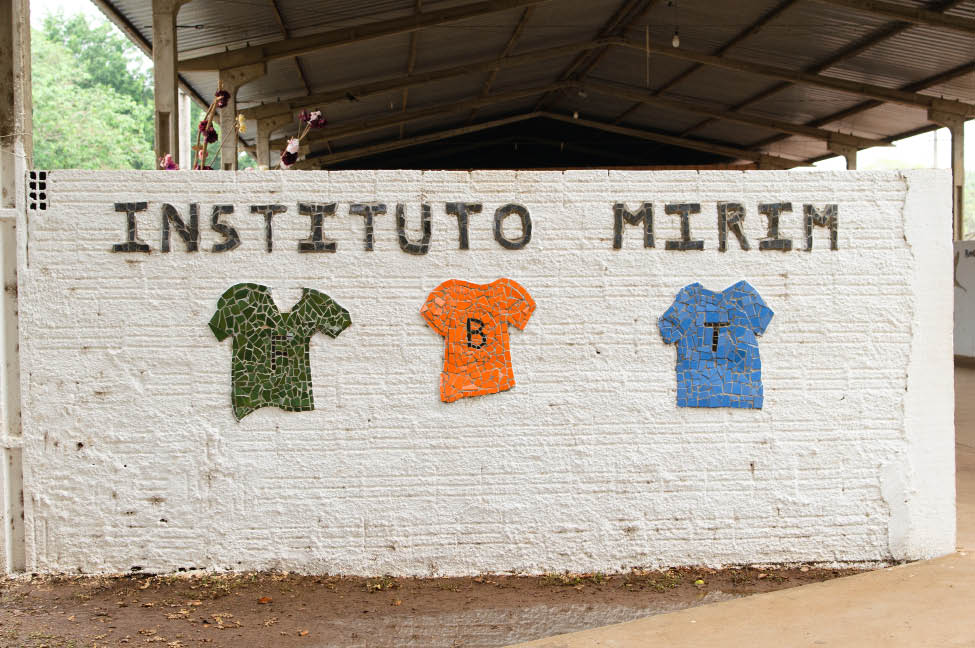
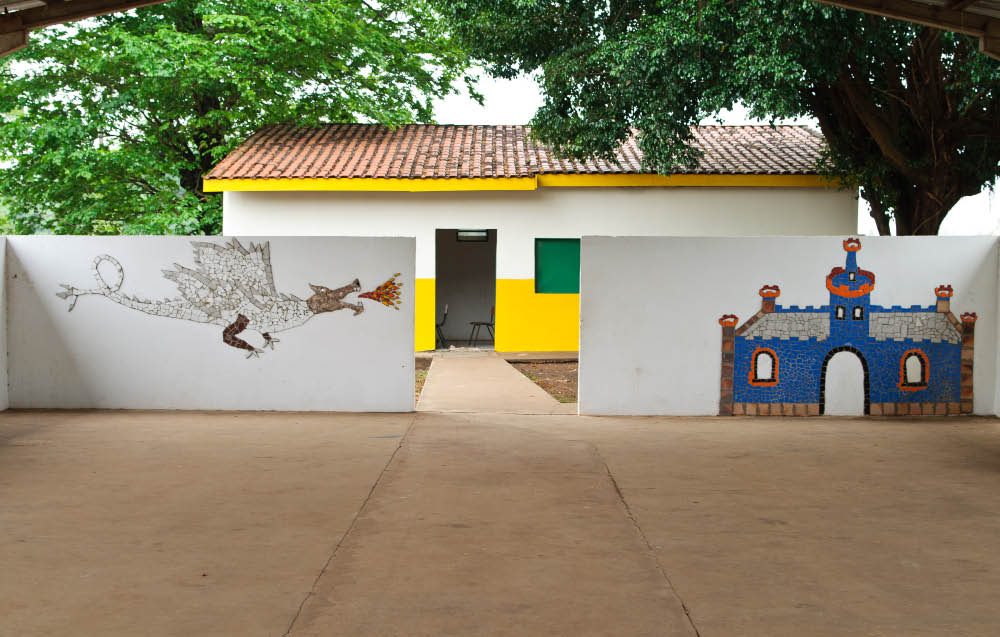
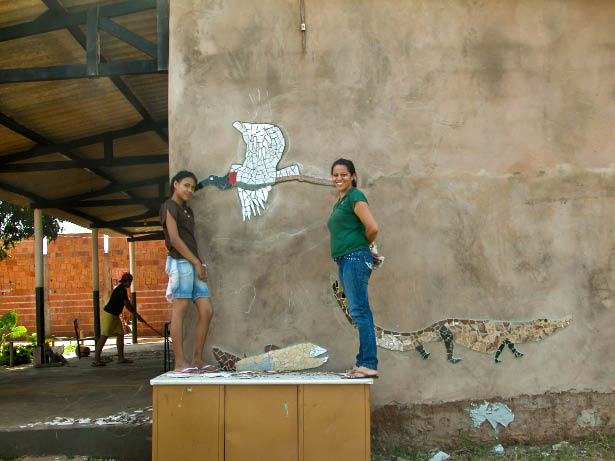
Nem fazia idéia se existia se não existia, essas coisas assim. Não fazia nem a mínima ideia o quê que era. Na hora que, assim, a primeira parte que a gente faz é difícil. O Robert falou assim que tem que ir juntando as peças. Fomos ajuntando as peças, era difícil. Aí na segunda etapa também era difícil. Agora que a gente vai pegando o jeito é mais fácil de fazer. É sim. É legal, é outro tipo de arte que nós aprendemos, não é igual aquelas artes que a gente aprende na escola. É outro tipo de arte de fazer desenho com pisos, essas coisas né, animais....
I had no idea if they existed or not, things like that. I didn’t have the slightest idea what it was. So at that time, the first part we did was difficult. Robert said that we had to assemble the pieces. Assembling the pieces was difficult. Then the second step was also difficult. Now we are getting the hang and it is much easier to do. It is. It’s cool, it’s another kind of art that we learn and is not like those arts that we learn in school. It’s another kind of art to make drawings with tiles, to make these things, animals....
Com os Professores
With the Teachers
to build a better world ...
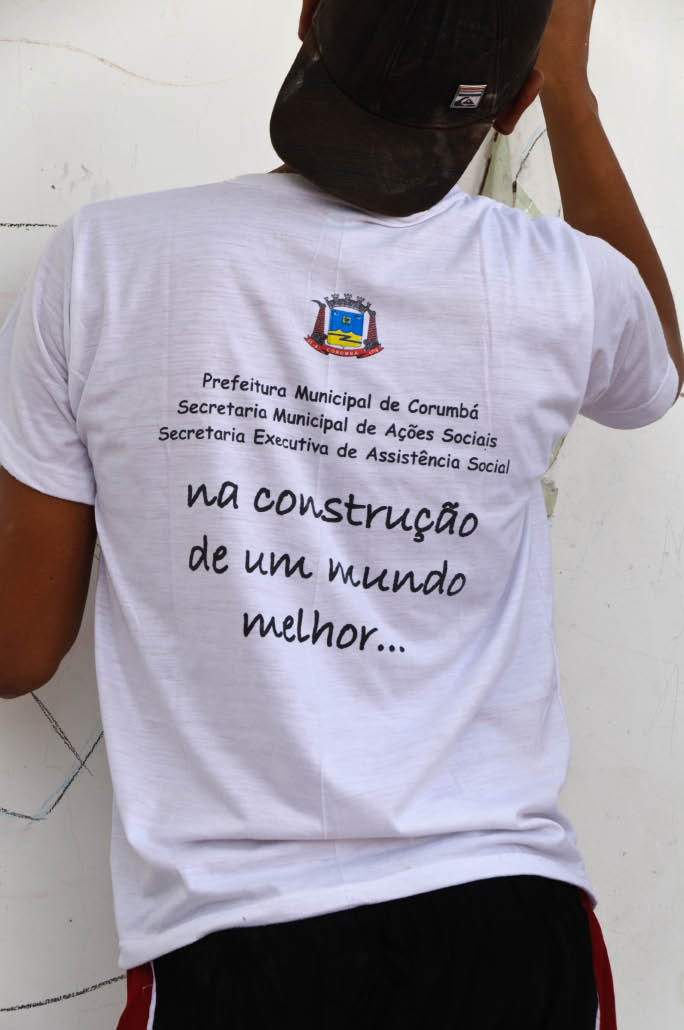
Amor, Educação e Arte em Mosaico
É um tema que se enquadra perfeitamento ao trabalho desenvolvido pelo artista plástico Robert Joseph Markey e a enfermeira Julie Elizabeth Orfirer. Eles se propuseram a andar pelos países, semeando conhecimento a arte. Despojados de qualquer receio quanto as desenvolvimentos dos trabalhos ou de ficarem privados das comodidades da vida moderna, iniciaram a empreitada, saindo do primeiro mundo para interagirem com pessoas dos países em desenvolvimento como o Brazil. A Polícia Militar Ambiental de Mato Grosso du Sul, foi agraciada com o benemérito trabalho dessas duas almas, que preocupadas com as crianças e adolescente, os quais são mais sensíveis as belas coisas do mundo, ensinaram em nosso estado a arte em mosaico.
Felizmente Corumbá foi inserida nesse contexto, a sentimo-nos orgulhosos, de a 2° Companhia de Policia Militar Ambiental, participar desse evento onde, a educação, a arte, o meio ambiente e o intercambio cultural foram a razão de tudo: O princípio o meio o fim.
Foram duas semanas de atividades onde duas turmas específicas foram trabalhadas na arte do Mosaico. Uma delas formado por vinte crianças com idades variando entre 9 a 12 anos, matriculadas na escola municipal CIAC, super animadas com a atividade extra sala de aula. Entre meninas e meninos, todos tomaram conhecimento da proposta dos americanos, cidadãos do mundo. Embarcaram no sonho de fazer um mundo melhor com cores e caquinhos. A outra turma, e não menos interessada, formada pelos representantes da nossa adolescêntes, também chamadas de “Aborrecências”, embarcaram na mesma nau dos sonhos e empenharam-se em mudar o mundo, embora estejam vivendo um momento de transformação, onde num primeiro momento as coisas paracem muito complicadas, consequiram efetuar verdadeiras obras de arte tornando o difícil bem mais fácil. Paredes onde antes se via nada se tranformaram em espaço de criação e os animais do Pantanal foram colocados em evidencia. O Projovem do CRAS II foi protagonista também desse espetáculo, sem ostentação, de arte, cultura e educação.
A Policia Militar Ambiental só tem a agradecer a semente plantada pelos naturalistas Robert e Julie e pedir a Deus que os proteja, a transforme seus sonhos em realidade. Eles devem retornar ao seu país de origem com a certeza de que a semente foi lançada em terra fértil.
Antonio Rondon da Silvá
Corumbá MS 26 novembro de 2010
Love, Education, and Art in Mosaic
It is a theme that fits perfectly with the work of artist Robert Joseph Markey and nurse Julie Elizabeth Orfirer. They set out to walk the country, sowing the knowledge of art. Stripped of any concern about the developments during the work or being deprived of the conveniences of modern life, began their venture, leaving the first world to interact with people in developing countries like Brazil.The Environmental Police of Mato Grosso du Sul was awarded the meritorious work of these two souls, concerned with children and adolescents, who are more sensitive to beautiful things in the world, and here in our state, the art of mosaics was taught.
Fortunately Corumbá was inserted in this context, we of the 2nd Company of the Environmental Police are proud to participate in this event where education, art, environment, and cultural exchange are the central focus of everything: The beginning, the middle, and the end.
There were two weeks where two classes of specific activities were taught in the art of mosaics. One consisted of twenty children aged 9-12 years, enrolled in the school CIAC, super excited about the extra classroom activity. Between girls and boys, everyone became aware of the Americans, citizens of the world. They embarked on the dream of making a better world with colors and with bits of tile. The other class, no less interested,was formed by representatives of our adolescents, also called “Aborrecências”. They boarded the same ship of dreams and strove to change the world. Although they are living in a moment of transformation, where at first things look pretty complicated, they then make true works of art and the difficult becomes easy. Walls where we used to see nothing were transformed into a place of creation and the animals of the Pantanal emerged. Projovem, without ostentation, was also at the enter of this project of art, culture, and education.
The Environmental Police have only to thank the seed planted by naturalists, Robert and Julie and ask God to protect them, to turn their dreams into reality. They must return to their country of origin with certainty that the seed was planted in fertile soil.
Antonio Rondon da Silvá
Corumbá MS November 26, 2010
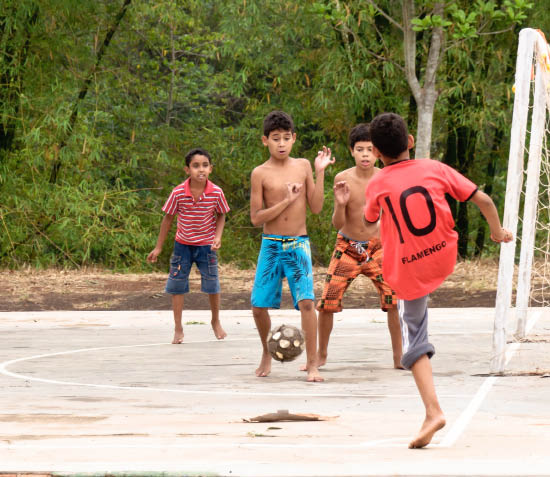
Americanos tem que jogar mais futebol.
Americans need to play more soccer.
Um agradecimento especial a artista brasileira Bel Borba que me inspirou a fazer “arte de rua” mosaicos.
Special thanks to Brazilian artist Bel Borba who inspired me to do “street art” mosaics.
